




Become a member of the Evergreen Society by setting up a monthly gift to support Reedies.
As reassuring as a misty Portland rain, your ever-present support will sustain the intellectual endeavors of Reed students and the faculty who inspire them.
When you set up a monthly gift, you make an impact on student discovery every day of the year, from Convocation to Commencement.

REED.EDU/EVERGREEN

“Reed
was instrumental in making me who I am and helping define the boundaries I follow, break, and seek to create.
Lifelong friends, a love of learning, and deep insights about myself are constant companions thanks to my time at Reed.”
Fall 2024 Volume 103, No. 3
EDITOR
Katie Pelletier ’03
ART DIRECTOR
Tom Humphrey
WRITERS/EDITORS
Bennett Campbell Ferguson
Cara Nixon
CLASS NOTES EDITOR
Joanne Hossack ’82
REEDIANA EDITOR
Robin Tovey ’97
GRAMMATICAL KAPELLMEISTER
Virginia O. Hancock ’62
CREATIVE DIRECTOR
Lauren Rennan
EXECUTIVE DIRECTOR OF PUBLIC AFFAIRS AND COMMUNICATIONS
Sheena McFarland
Reed College is an institution of higher education in the liberal arts and sciences devoted to the intrinsic value of intellectual pursuit and governed by the highest standards of scholarly practice, critical thought, and creativity.
Reed Magazine provides news of interest to the Reed community. Views expressed in the magazine belong to their authors and do not necessarily represent officers, trustees, faculty, alumni, students, administrators, or anyone else at Reed.
Reed Magazine (ISSN 08958564) is published quarterly by the Office of Public Affairs at Reed College. Periodicals postage paid at Portland, Oregon.
Postmaster: Reed Magazine
3203 SE Woodstock Blvd. Portland, Oregon 97202-8138
503-777-7591
reed.magazine@reed.edu www.reed.edu/reed-magazine
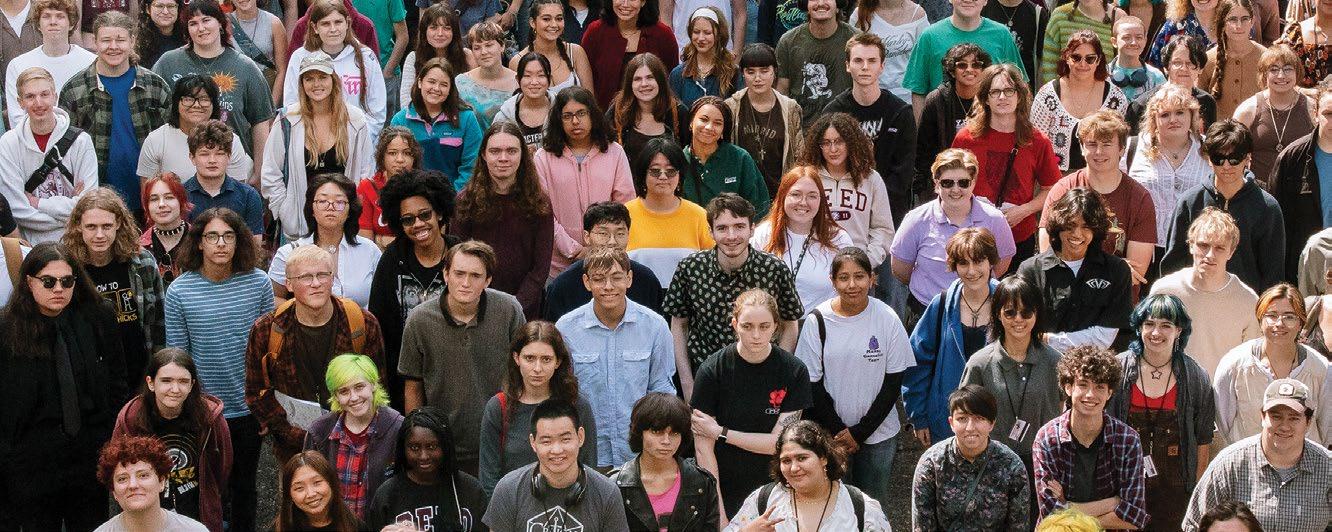
I attended parent night at my children’s school this week—my oldest is entering first grade and my youngest preschool. Toward the end of the event, the principal of the school asked the parents to form a circle. When we had, she told us to imagine the students in the middle of it and to think about how we were all there to create a community of care for them. I’m a little embarrassed to say I got choked up.
But it was familiar, too. I had a similar experience last spring at thesis parade. I was late getting outside of Eliot Hall to see the march, and by that time the seniors had already disappeared into the library. Outside, though, it seemed like the entire student body had shown up—along with faculty and staff and some alumni, too—and they were lining up to create the long tunnel of outstretched arms that the seniors run through each year when they emerge from the old library west entrance. The gathered students whooped, hollered, and drummed. When the seniors emerged, the waiting crowd cheered and the seniors ducked through the tunnel. It struck me, as it does some years during this and other community events, how close we all are, and how wonderful it is to experience students’ exuberance and genuine pride for one another.
That tunnel stretched from the library to Eliot—but we all know it
goes farther. Alumni are curious about and excited for these graduates—as they told us last fall in our readership survey, ranking our annual “What is a Reedie” feature a top favorite. We’re pleased to introduce you to the class of 2024 here, in this year’s edition. Also in these pages, Center for Life Beyond Reed Director Alice Harra reports that alumni are eager to support students in preparing for their post-Reed lives. In our Beyond the Great Lawn department we illustrate the many ways in which alumni dedicate time and resources to help recruit Reedies, provide support and opportunities for them, and, after students graduate, welcome them into an alumni community that spans generations and continents—and still finds ways to stay close, like a great circle gathered around us.
I often take for granted that working on campus means that with the arrival of each first year class and the graduation of each senior class I have a front row seat to the student body’s continuing evolution. At times it can feel like things have changed considerably, but it’s the same as it ever was. We hope this issue of the magazine shows you the way your continued engagement also surrounds us.
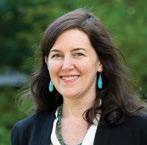
—Katie Pelletier ’03, Editor

Sheena McFarland
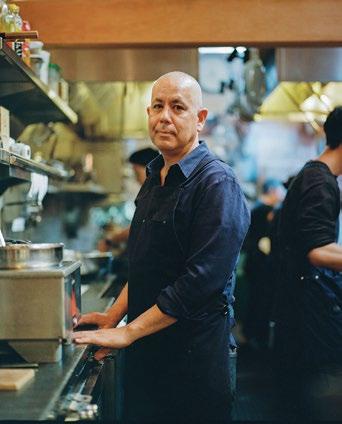

I was saddened to learn of Professor Nicholas Wheeler ’s passing [March 2024]. As for every physics student I knew when I was at Reed in the 1960’s, Wheeler’s course in Classical Mechanics was my favorite. His lectures were transporting: one could follow them enraptured or one could take notes, but one could not do both at the same time. Fortunately Wheeler solved that problem by handing out gorgeously written transcripts. Most of all I remember how when he would come to a particularly difficult piece of mathematics which he had undoubtedly worked through but which he knew would take too long for us to grasp without derailing his lecture he would simply say, “If there is justice in the universe…” I have always been grateful for his teaching me that lesson about teaching, which I often used in my own career as a faculty member.
JOHN CUSHING ’67 (THE OTHER ONE) PORTLAND, OREGON
I have recently become aware that the elected position of Student Body Pope is now a tradition. In the name of historical accuracy, and a bit of self-aggrandizement, I would like to shed some light on its origins.
In 1979, my slightly twisted imagination concocted the position, and, with the support of my friends, it was included as a new write-in position on the crude ballots that were used at the time. As the only candidate, I won, albeit with only a few dozen votes.
I am not aware of this position existing prior to this.
RICK BONEY ’82
PORTLAND, OREGON


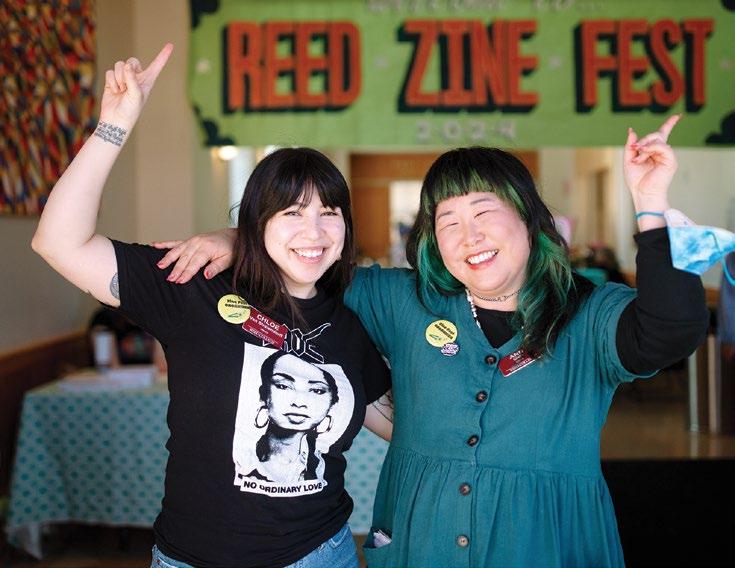
The Reed Zine Library, directed by Ann Matsushima Chiu and Chloe Van Stralendorff, is one of the most vibrant parts of campus, with a collection covering topics like the occupation of Alcatraz by Native American activists and the history of kaiju.
On March 30, Ann and Chloe amplified Reed’s zine community, welcoming an estimated 850 Reedies and guests to the inaugural Reed Zine Fest, which was so successful that a second event is already in the works. Around 90 zinemakers filled Kaul Auditorium, presenting titles like Anhecomics: Comics About Feeling Blue and I’m Having Top Surgery: An Illustrated Guide For You and Me, followed by a punk show in the library.
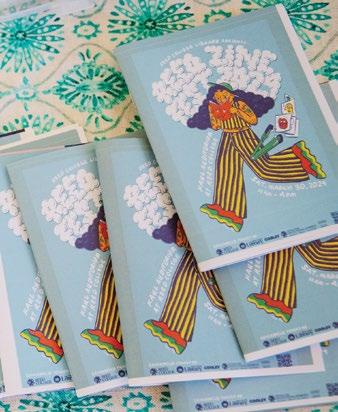
Committed to making Zine Fest as inclusive as possible, organizers required attendees to wear masks to protect immunocompromised guests. “Some people said, ‘I haven’t been able to attend a zine event for many years because not all of these events are masked,’” Ann says. “It’s a part of Portland zine culture at this moment to create accessible spaces. That’s really important in terms of the ethics of zines right now.”
—Bennett Campbell Ferguson
Among the highlights of Zine Fest was keynote speaker James Spooner, the graphic novelist and filmmaker behind the documentary Afro-Punk. “We wanted to showcase to students that James started off making zines and doing a lot of mutual aid and living in punk houses,” Ann says. “And now, fast forward, he’s traveling around, going to all these zine fests, and becoming this role model.”

History-literature major Milo Wetherall ’24 has won the prestigious William T. Lankford III Humanities Award for his thesis work on the memorialization of the Paris massacre of 1961.
The award, honoring Prof. Bill Lankford [English and humanities 1977–83], recognizes accomplishments in the history and literature disciplines and is given to students with outstanding academic records and strong potential for further achievement.
Milo’s thesis, “‘C’était en plein Paris’: Remembering the Massacre of October 17th, 1961,” focuses on the Paris massacre of 1961, when Algerian colonial subjects, who had been peacefully protesting against racist police violence and French colonial rule, were killed by city
police. Hundreds were murdered, but the scale of the massacre was obscured by the French government for decades. In his project, Milo looks at three works from the 1990s that attempt to bring public attention to the event: a journalistic account of the night, a documentary, and a novella.
“I am honored to receive the Lankford Award,” Milo says.
“I would like to thank my thesis adviser, Prof. Catherine Witt [French 2005—], and my first reader, Prof. Liz Matsushita [history and humanities 2022—], without whom I would not have been able to do this work.”
Milo originally came to Reed never having studied French. But through the French and history departments, he was able to take
French classes and study abroad for a semester in Paris, making historical and literary research in the language possible.
Though Milo’s project focuses on the latter half of the twentieth century, Milo says there are connections to be made to events happening today.
“The current situation in Gaza underscores the continued relevance of the study of literature and history in relation to state violence,” he says.
Next, Milo will be heading to France to work as an English language assistant through a French Ministry of Education program. After the program, he hopes to go on to graduate school to continue his thesis research. —Cara Nixon
Le Silence du fleuve (1991) by Agnès Denis and Mehdi Lallaoui, a documentary that attempts to shed light on the massacre using witness accounts.
Le Seine était rouge (1999) by Leïla Sebbar, a novella about characters trying to uncover the suppression of Algerian demonstrators by Parisian police.

POSTCARD: BARCELONA DREAMS
Prof. Kris Anderson [psychology] journeyed to Barcelona as part of Reed’s faculty research exchange. Her visit to a residential treatment facility there taught her about the universality of the struggle to overcome addiction.
I spent almost two weeks in Spain in March 2024 as part of Reed’s new faculty research exchange program. I had an amazing time in Barcelona getting to know my exchange partner, Dr. Noemí Pereda from the University of Barcelona. In addition to research meetings and presenting my own work, I had the opportunity to see quite
a bit of Barcelona (including Palau de la Música Catalana), visit with Reed students in Reed’s Barcelona Universities Program, and participate in the International Women’s Day March with members of Noemí’s lab. The most poignant part of my trip was a day spent at Projecte Home Catalunya, a residential treatment community for individuals living with addiction. As I wrote at that time, “While most of us did not share the same language, one thing was quite clear: The pain of addiction is universal, hope in recovery is the same everywhere, and the connection between people doing this work transcends culture.”
—Prof. Kris Anderson
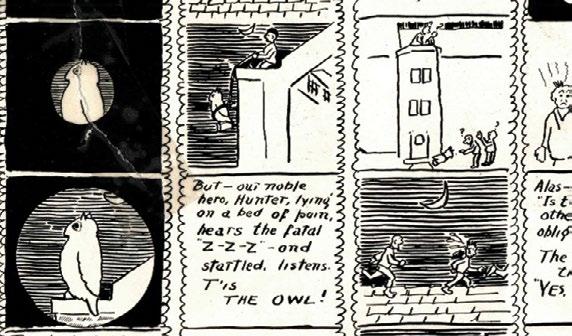
FIND THESE STORIES AT: reed.edu/reed-magazine
“Before the Doyle Owl was a slab of concrete painted red, battered and bruised from years of scuffles, it was a simple, albeit large, statue stolen by students. But how was it stolen? Why? And what started the snatching between dorms, the beloved tradition of tussling over the owl?” Learn about the origin story of this Reedie tradition with archival information collected by Jon Bates ’67
The Environmental Humanities initiative launched its second Mellon-funded summer incubator for faculty. Professors from an array of disciplines have spent the summer developing curricula focused on questions of environmental justice in the arts and humanities. “It’s giving students an outlet where their passions can land,” says Prof. Kristin Scheible [religion].
Congratulations to Darlene Pasciezny ’01, who was voted the 2024 Babson Society Outstanding Volunteer for her work connecting and engaging the Reed community. Steve Falk ’83 and Barbara West ’64 were also recently honored with Distinguished Service Awards for their major contributions to the community and college.
Nicole Chan ’25 has won the prestigious Goldwater Scholarship, which recognizes college sophomores and juniors who show exceptional promise of becoming the next generation of research leaders in the natural sciences, engineering, and mathematics. Learn more about her work to understand human illnesses.
The Korean-American composer, vocalist, and multi-instrumentalist presented her song cycle Casual Miracles to an enraptured audience.
At first glance, the bike bell tree— an instrument invented by Prof. Bora Yoon [music]—looks like nothing more than bike bells strapped to a pole. Yet to Yoon, it is something more: a direct line to a deity.
“To me, it just sounds like a telephone,” Yoon says of the bike bell tree, which features in her song cycle Casual Miracles. “That’s actually how it’s used in Casual Miracles—to initiate a telephone call with God, or a pontification of what it might look like in heaven when She passes out souls.”
Last March, Bora and the bike bell tree made their Carnegie Hall debut, unleashing the multifaceted splendor of Casual Miracles on a sold-out audience (as part of the Heard concert series). It was a landmark moment in Bora’s career, spotlighting her versatility, her spiritual depth, and her determination to obliterate the boundaries imposed on symphonic music.
“The symphonic world has been in a pit of concern for as long as I can remember,” Bora says. “They’re always like, ‘We have blue-haired donors that are going to die very soon, and once they do, who is going to fill these audience seats? How do we get young people to like orchestra music?’ But it’s the culture. It’s this entire thing of being trusted with the keys to the Lamborghini.”
When Bora is at the wheel, she drives audiences and musicians alike to mesmerizing destinations,

whether she’s recruiting bicycling sopranos to sing in doppler effect or translating her fascination with the divine feminine and the miracle of birth into music—two themes that flow through Casual Miracles. Bora began work on Casual Miracles when she was a graduate student at Princeton University, creating a work composed of five songs—“The World is Held Together by Invisible Knots,” “Day of the Dead,” “Soul Lottery,” “Two Wolves,” and “Three Ways to Look at the Ocean.” They’re bound together by her narration, which is rife with mischievous asides like “God is a crafty bitch,” inspired by the Rev. Edwin Chinery at New York’s progressive Church of Ascension, which Bora describes as her musical and spiritual home. Performed by the contemporary music ensemble Alarm Will

Sound, Casual Miracles sees Bora drawing upon an eclectic panoply of collaborators and influences: Merrill Garbus’ eclectic music project Tune-Yards, Aussie electronic producer Ben Frost, and the South Korean musical storytelling tradition of Pansori.
At Carnegie Hall, the contemporary music ensemble Alarm Will Sound performed Casual Miracles, a song cycle composed by Bora Yoon, pictured below.

After bringing Casual Miracles to Carnegie, Bora is continuing to push symphonic music beyond what she calls “the canon of the dead white European male.” She continued that quest in August, premiering her latest orchestral experience, PARHELION, at the Cabrillo Festival of Contemporary Music in Santa Cruz.
For Bora, playing Carnegie Hall was a milestone in a long journey. “On a personal level, I cherished the full-circle nature of living out a childhood dream to ‘make it’ to Carnegie one day,” she says. “[I feel] very blessed and grateful for the wonderful musicians I got to be on stage with…while also honoring all the amazing women in my life, focused on the casual miracle of giving (and fostering) life.”
—Bennett Campbell Ferguson
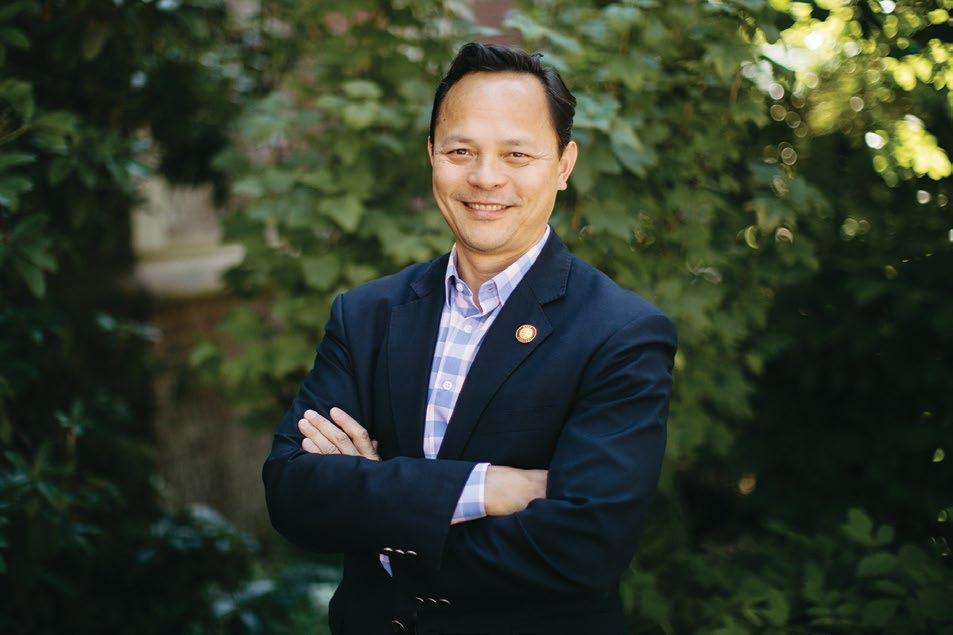
In July, Hieu T. Nguyen succeeded Hugh Porter as Reed’s Vice President for Advancement and College Relations, overseeing advancement, alumni relations, the Center for Life Beyond Reed, college relations information systems, and communications.
“He will engage in new ways to ensure Reed continues to grow as one of the most multiracial, multicultural, intellectually serious colleges in the world that is accessible to students regardless of their financial background,” said President Audrey
Bilger. “I am delighted to welcome Hieu to campus and look forward to working with him.”
Hieu, the former Vice President for Advancement at Harvey Mudd College, said he is “honored” to be part of the Reed community.
“I am excited to join the college during an exciting time to further engage, activate, and extend Reed’s impact on society with its talented students, dedicated alumni, impressive faculty, skilled staff, and supportive families,” Hieu said.
Deborah D. Kamali ’85 was elected chair of the Board of Trustees in February, becoming the first woman to lead the board. She succeeds Roger M. Perlmutter ’73.
An emerita professor of Obstetrics, Gynecology, and Reproductive Sciences at the University of California, San Francisco, she has been a prominent member of the Reed community, serving as chair of Reed’s Strategic Planning Partners and chair of the Student Life Committee.
“Reed has been an important part of my life and my family’s life for many years, and I look forward to serving as chair of the Board of Trustees,” Deborah said.
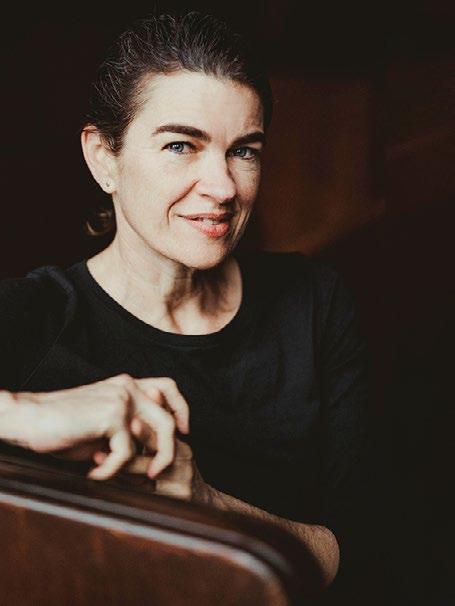


By Sheena McFarland
For more than a century, Reed has graduated lifelong learners into the world. Students come to engage with a world-renowned academic program that supports their intellectual development. For the past decade, Reedies have had another partner to support their development and success: the Center for Life Beyond Reed (CLBR), where students learn how to extend their education beyond the academic year into three summers and four winter breaks, with opportunities beyond Reed such as internships, research, clinical experience, job shadowing, conference attendance, creative endeavors, and more.
“Reedies love to ask big questions, tackle hard problems, and dedicate time to their community to solve intellectually and morally challenging issues facing the world,” said Reed President Audrey Bilger “CLBR is really good at helping students talk about what they’ve learned at Reed so that their talents can become legible to people. Thanks to significant growth in donations to this program, we are now able to support more students to help them make the impact on the world they hope to have.”
CLBR’s integrated advising model is unlike any in the coun -
try. Advising for graduate schools, careers, and national fellowships is woven together so that students are exposed to a broad range of opportunities outside of the Reed campus. Associate Director of Data and Systems Nate Martin ’16 leads the CLBR fellowship operations and works closely with the faculty on these prestigious awards requiring institutional nomination. Reed was this year again named a Fulbright Top Producer.
“CLBR believes deeply in a Reed education as a strong foundation for success in any field,” said Center for Life Beyond Reed Director Alice Harra. “We are committed to helping students express the value of the liberal arts in the 21st century. When we do our work well, students have clarity of purpose, skills, connections, and confidence to translate their Reed education into any postbaccalaureate outcome, including graduate school, work, a national fellowship, and more.”
Many colleges and universities require students to seek out support and to largely know what they want to do after they graduate in order to access resources. At Reed, CLBR’s four professional advisors are aligned by Communities of Purpose, a Reed-like framework which looks at careers through a
lens of problems solved in community with others who share their purpose, such as Sustainable Life on Earth, Scientific and Technical Innovation, Art and Beauty in the World, or many others (see sidebar).
“We start with students’ ‘why’ and help them articulate why they want to do what they want to do, and that can lead to a lot of different worlds,” Martin said. “That is really my favorite part.”
Students can apply for funding from CLBR even in their first year to explore their purpose during summer or winter break, when they can engage in experiences to determine whether a specific field or career is right for them.
“What I’ve seen from students who come back from these experiences is sometimes they come to a realization and say, ‘I didn’t know I wanted to do that, but this internship really opened my eyes,’” Bilger said. “Or conversely, ‘I was sure about what I wanted to do when I came to Reed, but a summer internship convinced me that I want to reach back and think about some other areas of interest because I’d rather do that.’”
CLBR advisors seek to help students find paid summer opportunities and when students want to gain valuable experience with nonprofit or government organizations focused on social work, education, social justice, journalism, and more, Reed is able to support some students with the Summer Internship Fund for internships in fields that are historically unpaid.
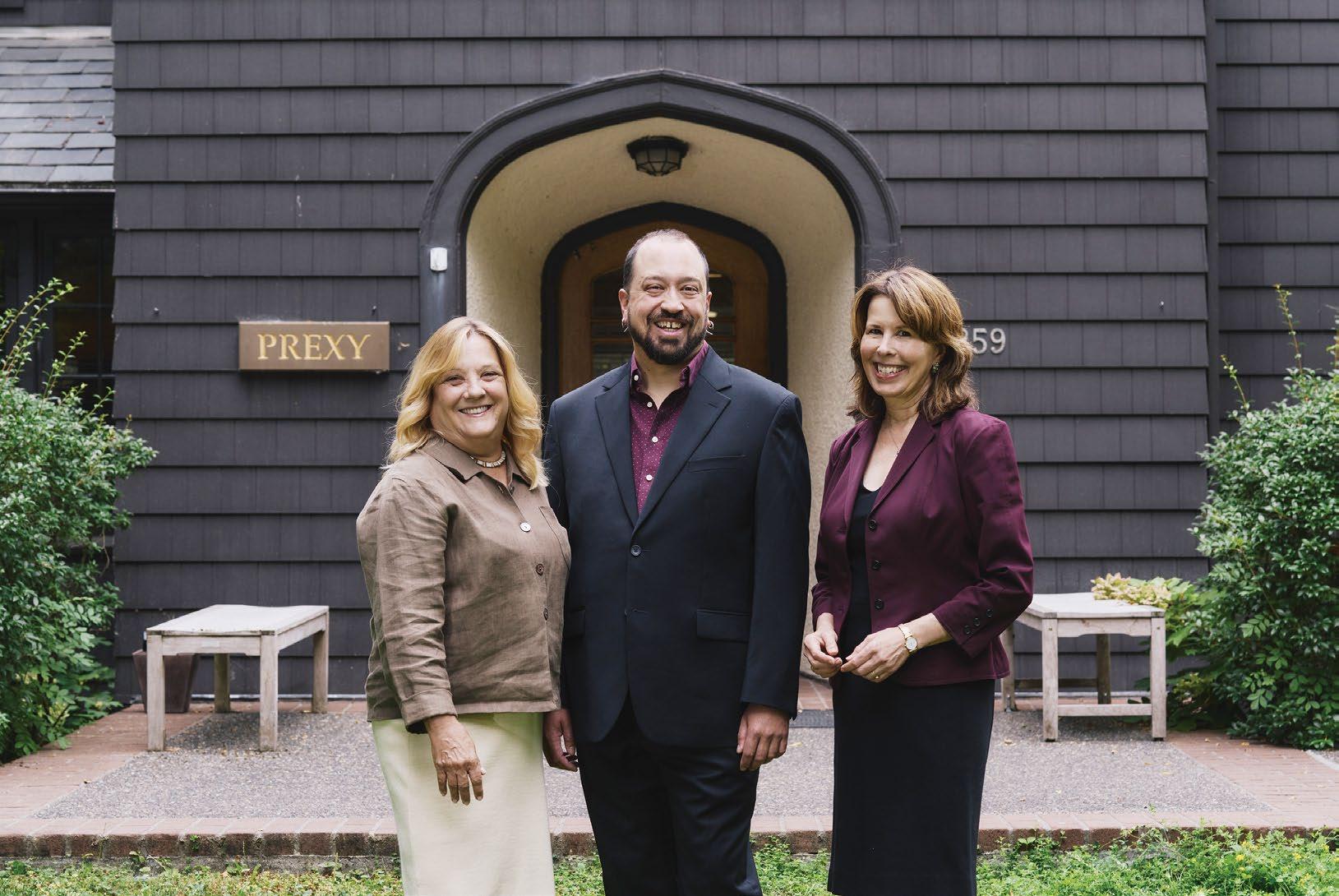
In addition, the Career Advancement Fund helps students yearround with up to $500 to explore their purpose through conferences, professional clothes for internship or job interviews, and more. Reed’s Annual Fund contributes to the College’s operating budget, allowing services such as CLBR to support students’ career exploration.
CLBR programs have expanded significantly because of generous support from Reed alumni and friends. Alumni in particular have long expressed eagerness to help Reed students take those critical first steps after graduation. Donations of all sizes have impacted these programs, including leadership gifts to create endowments to support student internships, career-based exploration treks, the career advancement fund, and a signature endowment to establish the President’s Summer Fellowship.
“We are very grateful for Reed’s
engaged alumni and parent community who generously provide funding for student opportunities, especially for those students who would be unable to pursue their purpose without it,” Harra said.
The CLBR model is being noticed by colleges around the country, who reach out wanting to learn more about it after hearing about Reed’s approach at national professional conferences where the CLBR staff present.
Bilger appreciates CLBR’s engagement with students to help them succeed and thrive after graduation.
“We want our students to find their path to an enriched life in which they feel satisfied, and the concept of purpose particularly resonates,” she said. “Feeling like you’re living a fulfilled life as a lifelong learner is really key. That is conveyed by the name and the work of the Center for Life Beyond Reed.”
9 Communities of Purpose
Arts & Expression
Citizenship & Community Living
Education & Human Potential
Entrepreneurship & Business Strategy
Globalization & Diplomacy*
Healthcare & the Cure of Illness
Investing & Financial Responsibility
Research & Innovation*
Sustainable Life on Earth
Tech & Builders*
*Top 3 most popular communities of purpose
Reed Graduates*
Working: 63%
Grad school: 18%
Still looking for job or school: 13%
Volunteering: 2%
*Average over the past 6 years
65% of Reedies pursue continuing education, making Reed top 4 in the nation for PhDs


WHeN i WaLk iNTO RiNtaRO, a Japanese izakaya in the Mission District of San Francisco, Sylvan Mishima Brackett ’98 is waffling over a word. He sits at one of the handmade wooden tables with his laptop, in a neat button-down with the sleeves rolled up, and asks me, “What’s a better term for ‘add-ons?’” When his team of cooks sits down to go over the menu with him for the night, he asks them too. Enhancements isn’t right. What about supplements? He decides it works after some deliberation. As I shadow him in the hours before dinner service, I come to realize this is how he operates as a chef: with extreme attention to detail. It shows in everything—the intricate design of the menu; the handpicked fresh ingredients used in every meal; the precision with which he slices perfect squares of goma dofu or identical strips of udon.
The restaurant space itself is a testament to his meticulousness. Nearly everything, not only the food you eat, but the table you eat it on, is handmade with care. Sylvan’s father, Leonard Brackett ’70, who trained as a temple carpenter in Kyoto, crafted the space himself, using redwood from old wine tanks and cedar he found on the Oregon coast. From the beams that line the narrow space’s ceiling to the bar slab, booths, and tables, Len’s elite handiwork is everywhere, a companion to Sylvan’s cooking artistry. Sylvan’s new cookbook, Rintaro, is dedicated to him and his memory.
Rintaro opened in 2014 and has been Michelin recommended since 2016. Given the restaurant’s quick success, Sylvan hadn’t found the time to release a cookbook until the fall of 2023. His wife, Jenny Wapner ’99, whom he first met outside the student union at Reed, edited and published the book. Rintaro promises to translate “the experience of a Tokyo izakaya to the home kitchen,” with recipes for sashimi, tofu, udon, and more. The idea is to make replicating the dishes of Rintaro possible at home, after a decade of carefully cultivating the space, the experience, and of course, the food.
The intense focus on the food began before Sylvan even found the restaurant space in the Mission. Prior to opening Rintaro, he diligently hunted for the best local ingredients—authentic wasabi from Half Moon Bay, bamboo shoots from Livermore, fresh herring from Monterey. Sylvan says
finding those local, fresh ingredients, ones with “life and vitality” in them, as he puts it, has been key. Almost all of the ingredients in the dishes at Rintaro come from somewhere along the West Coast—not including the shipment of fish that comes in from a Tokyo fish market every Friday. Sylvan thinks of fish from Japan like truffles from France or caviar from the Caspian Sea. It’s “more interesting to taste the place” it really comes from, he says.
Part of Sylvan’s dedication to local ingredients is the sustainability aspect, but the other driving factor, he says, is that it just tastes better. And his philosophy on local ingredients extends to the entire Rintaro experience. “You’re tasting a specific time in a specific place. You couldn’t have that same meal somewhere else in a different time of year,” he explains. “You’re eating a moment.”
“Sylvan” and the Japanese version of the name, Rintaro, mean “boy of the woods,” and growing up, Sylvan fulfilled that destiny. He was born in Kyoto—where his mother, Toshiko Mishima, is from—but was raised in the rural Sierras of Northern California, the kind of place, he says, with “outhouses and kerosene lamps,” in a Japanese-style house his father built.
Though Sylvan writes in the cookbook that he never expected to become a chef while he was growing up, much of his childhood centered around food. Dinner was always important to his family, and looking back, he is amazed at how much work his mother put into cooking them incredible meals each night, his favorite being her gyoza. Every few summers, he would return to Kyoto with his mother and his sister, Aya, where he fondly remembers slurping miso soup for breakfast and eating futomaki—thick sushi with simmered vegetables, egg, and shiitake—on special occasions.
Even sitting with his father in his woodshop informed Sylvan’s future as a chef. He says he sees lots of similarities between how his father approached carpentry and how he now approaches cooking. Len was obsessed with curating relationships with millers and loggers for his lumber to ensure he got first pick on the best wood. Sylvan is equally obsessed with business bonds—apart from his wife, he says he spends the most time on the phone with his fish supplier.

In a 2018 interview with the San Francisco Chronicle about the woodworking of Rintaro, Len said that he suspected Sylvan's growing up in the woodshop contributed to his craftsman-like cooking style. “If you look at Rintaro, the dishes are beautiful and the chopsticks are beautiful,” he said. “It’s how he does everything.”
Sylvan’s passion for food continued as he grew. In high school, he opened his

first business—a pop-up restaurant for his senior project, where he served dishes like Japanese curry and pizza.
When he began looking at colleges, Sylvan didn’t initially want to go to Reed like his father had. But he fell in love with the intensity of the students, the way professors took those students seriously, and the strong personality of the campus. At Reed, Sylvan was able to further explore and improve his cooking skills. He made scones
for the Paradox and threw themed dinner parties: a Moroccan-focused spread, tamale night, and once, after he’d dreamt about it, an entire meal made from apples. “It was actually really terrible,” Sylvan recalls of that particular party. “It was a total failure.”
He studied history, and even that discipline allowed him to focus on his love of food. His thesis, completed under Prof. Raymond Kierstead [history 1978–2000],
focused on the development of taste as a cultural asset.
In the summers, Sylvan took kitchen jobs in Portland and San Francisco, and, one time, in France. He bought a motorcycle and shipped it across the world to ride around the French Riviera, but he spent much of the time “getting beat up,” as he puts it, working 14-hour days in a chaotic restaurant with only a half day off every week. Working long hours is something


else Sylvan says he learned from his dad, who worked 70-80-hour weeks during his temple carpentry training.
After graduating, Sylvan moved with Jenny to the Bay Area and lived in a studio, working temp jobs to get by. Eventually, he got connected with the famed Chez Panisse restaurant in Berkeley— they needed someone good with computers to digitize Alice Waters’s treasured address book, where the personal information of writers, musicians, actors, and royalty lived. That task would turn into assisting Alice for six years. During that time, no one at Chez Panisse knew Sylvan cooked. The most food preparation he did during that time was making Alice sandwiches. But for special events, he would type up the menu, with her directing him from her handwritten notes—an experience he now considers integral to his skills as a chef and restaurant owner.
After those six years, he decided to travel to Japan and learn technical skills in cooking. He spent six months working long hours at two restaurants, a highend kaiseki restaurant in a tiny neighbor-
hood of Tokyo, and Soba Ro, a restaurant in Saitama, where he learned everything from how to roll udon and make kaeshi—a seasoning base for soba broth—to how to care for guests and “cook with heart.”
When he returned to the States, Sylvan felt alive and inspired with ideas. He opened a catering company, Peko Peko, out of his garage in Oakland, popular for its artful bento boxes. But Peko Peko was only the beginning. He began to conceive the idea for Rintaro, a Japanese izakaya, traditionally a small bar with quick bites, and a type of establishment not yet present even in the Bay Area’s diverse food scene.
When Rintaro opened, it was met with acclaim—Bon Appétit named it one of its top 10 new restaurants six months after opening. Like the restaurant, the cookbook too has been quickly revered, appearing on the New York Times list for the best cookbooks of 2023. “Chef-driven cookbooks can often miss the mark of translating restaurant dishes for the home cook. Not here,” journalist Eleanore Park wrote.
As I watched Sylvan roll out udon dough and cut it by hand the old-fashioned way, I thought he did make it look easy. But the process takes a practiced hand. Despite having a staff of 45, Sylvan almost always hand rolls and cuts the udon noodles on his own. “It’s work that you can incrementally get better at for a very, very long time—it’s not like you figure out how to do it and you’re done,” he says. “It can always get better.” Earlier that morning, a cook had prepared the dough by kneading it underfoot, and in the afternoon, it had been kneaded again. In the low-lit back room a couple of hours before service, Sylvan lays out one of the off-white circles of dough on a monstrous cutting board to complete the process.
As he prepares his station, Sylvan explains that he tried every flour he could find in California for his udon before finding the right one across the ocean, in Kagawa Prefecture, Japan, a city sometimes referred to as "Udon Prefecture." Kagawa flour is ground super fine, which helps to make the noodles the right texture—silky on the outside and chewy on
the inside, or, in Japanese, tsuru tsuru, koshi ga aru. Taking a wooden dowel from its place on the wall, Sylvan begins rolling out the circle of dough, flattening it into a rectangular shape with rounded edges. He folds it into thirds and lays it on another narrower cutting board before taking an udon knife and cutting the folded shape into small strips. His hand is precise; the noodles look identical as he gently bunches them together, shakes the excess starch off, and folds them into a clear plastic bin. He quickly moves onto the next circle of dough, transforming it into more noodles without missing a beat.
As dinner time approaches, Sylvan runs around the restaurant, preparing a new dish in the kitchen and meeting with the servers to go over the reservations for the evening. The space is loud with the sound of crinkling foil and whirring fans, clanking plates and chopping knives. It smells like vinegar and heat. In the back room, a sous chef grinds down smoked fish with an old-school teal-colored machine, shaving katsuobushi: fragrant fish flakes with an intense umami taste. Sylvan calls it Rintaro’s “secret ingredient.” The flakes that fall into the bin look a lot like wood shavings, and I wonder if the homage to Len and his work is purposeful or accidental.
Patrons start arriving for reservations a few minutes before five, lining up outside the wooden Rintaro gate where a big red lantern sways in the San Francisco breeze. The host leads them in, calling “Irasshaimase!” to the rest of the staff, who call it back in greeting. In simple terms, it means “welcome” in Japanese, but Sylvan explains its subtext translates to “I see you, and I will take care of you.”
The restaurant is quickly packed, first-timers and seasoned customers at tables, booths, and the bar. It’s hard to say which offers the best experience— the outside tables allow for a view of the plant-filled patio; the beautifully constructed booths offer privacy; but the bar lets you look in on the kitchen, where you can watch as the cooks grind fresh wasabi, precisely slice raw fish, and assemble colorful plates with expert hands.
That’s where I sat while I ate a variety of dishes from the à la carte menu. I’ve never been to Japan, but the way Sylvan describes Rintaro—not fusion, but as if the Bay Area were a region of Japan— seemed to ring true. Eating fresh yellowtail with authentic wasabi; steamed, fluffy fish

cake in sweet, warm broth; juicy chicken yakitori; a carbonara-inspired udon (tsuru tsuru, koshi ga aru, just as Sylvan said it should be) with that flavorful katsuobushi; cheese katsu fried to perfection; and a soft mochi-covered strawberry to finish it off felt like taking a tour of traditional Japanese cuisine with fresh, local Bay Area ingredients.
The process of creating a whole experience for patrons is satisfying to Sylvan, and he puts thought into every piece of
to earn the title of “bad cook,” let alone a “good” one. But I took to my kitchen and spent an afternoon cooking a few of the dishes in the book, in an effort to re-create at least some of my Rintaro experience with a green bean and fruit shira-ae (tofu and sesame sauce); tonkatsu (pork loin katsu) with snowy cabbage and rice; and a grapefruit zeri (kanten jelly) for dessert.
Even for a true amateur like me, it went much more smoothly than I anticipated. I learned a lot along the way—how to toast sesame seeds without burning them (a delicate process); how to cut pork loin into even cutlets and fry them to golden-brown deliciousness; how to snow cabbage into thin strips; how to cook rice so it’s not al dente or mushy (another delicate process); and how to carefully pour and set grapefruit jelly into delicate rinds. As a typically impatient person, I learned how to take it slowly and mimic Sylvan’s attention to detail, remembering something he said about getting into a “flow state” while he worked.
When I asked Sylvan what he thought made Rintaro special, he pointed to two things: “I think the fact that we take the ingredients so seriously. And that when we do things we make almost everything by hand.”
The cookbook acts as an extension of those touchstones. I wasn’t sitting at a handmade bar and listening to the sounds of experienced cooks plating my food
"I LikE ThE eleMENT oF THRowiNG a PaRty BaSicAlly EveRy NigHT."
it—from the more significant elements like the handmade decor and the expertly crafted food to the finer details like the music that sounds through the speakers and the verbiage of the menu. When you eat there, it’s about the experience just as much as it’s about the food. As Sylvan says, “I like the element of throwing a party basically every night.”
It’s one thing to eat at a restaurant, and another to try and emulate the experience at home, which is the entire goal of the Rintaro cookbook. Inspired by the time I spent with Sylvan, I tried my hand at a few of the book’s recipes. To preface, I’m not a cook. By that, I mean I haven’t even cooked enough
when I ate my home-cooked meal, but I had the satisfaction of eating something I had created, made delicious by the local land. My presentation left something to be desired—I was in the process of unpacking when I cooked, so the food was served on paper plates—but it all tasted good, and that’s what mattered most to me. The spread included fresh fruit and vegetables grown on the West Coast and local meat raised fewer than 50 miles from Portland. In another time of year, in a different place, the dishes would have looked and tasted entirely different. Like Sylvan ensured at the restaurant, I wasn’t just enjoying a meal—I was eating a moment.
Cara Nixon is a writer for Reed Magazine.

After folding the dough into thirds on a long, narrow cutting board, Sylvan slices it into strips with a noodle knife, his hand incredibly precise.
Bunching the noodles together and shaking off the excess starch, Sylvan folds them neatly into an airtight container. Later, they will be cooked to perfection—chewy on the inside, silky smooth on the outside—and served to hungry customers.
Sylvan prepares to slice the udon dough by sprinkling his cutting board with potato starch in a low-lit back room of Rintaro.
The chef rolls out one of the flat disks of dough, called zabuton, with a wooden dowel. He transforms the circle into a square, and then extends the shape into a rectangle by rolling the dough around the dowel, unfurling it, rotating it, and then rolling it again. The dough is lengthened and flattened until the dough is an even thickness.


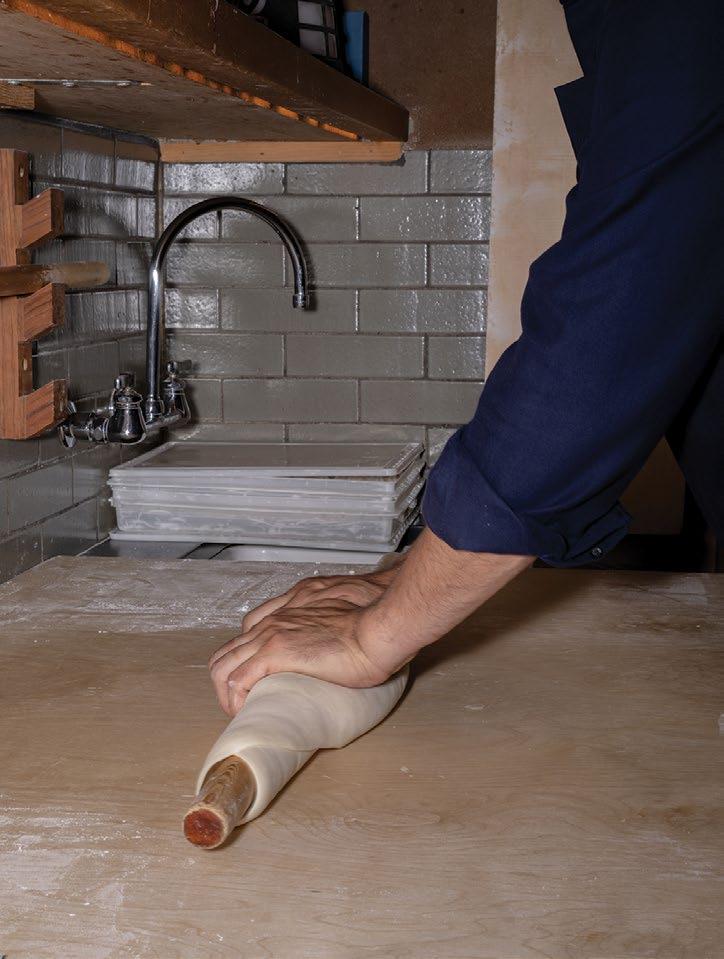




SPICY TOFU AND PORk OVER RICE
Mabodofu, like gyoza, is another Japanese version of a Chinese dish and was something my mother made frequently when I was a kid. Like curry, it’s a dish that’s incomplete without the accompanying rice. I’ve always found mabodofu deeply satisfying, and of all the foods we make at the restaurant, it’s the one I eat the most. Almost every night when I’m on the line, I’ll sneak over to the rice station to make a small taster portion myself. The mabodofu I make at the restaurant is based on a taste memory from childhood. Although the ratio of meat to tofu and the consistency is the same, I’ve made a few changes to the seasoning, replacing the fermented black beans my mother used with tobanjan, a Japanese-made Sichuan-style paste of fermented broad beans and chile peppers. I also add black pepper and ground sansho pepper to give it a multidimensional spiciness. Tobanjan is readily available in most Japanese grocery stores. And you should choose the best ground pork you can find. Although you can make mabodofu with medium or firm tofu, I prefer the lush texture of the silken variety. It’s very delicate, though, and if you’re not gentle in your handling of it, you’ll end up with a tofu scramble.
2 (14 oz/400 g) packages silken tofu
2 tablespoons vegetable or other neutral oil
1 tablespoon toasted sesame oil
3 tablespoons minced ginger
3 tablespoons minced garlic
1 to 3 Thai bird chiles, stemmed, seeded, and sliced
1 lb/450 g ground pork
1/2 medium yellow onion, finely chopped
8 tablespoons/167 g red miso
2 tablespoons sugar
2 tablespoons tobanjan
1/2 teaspoon ground black pepper
21/2 cups/590 ml chicken stock
2 tablespoons potato starch
FOr serviNg
Hot rice
Ground sansho pepper
Sliced scallions
MAKES 6 TO 8 SERVINGS
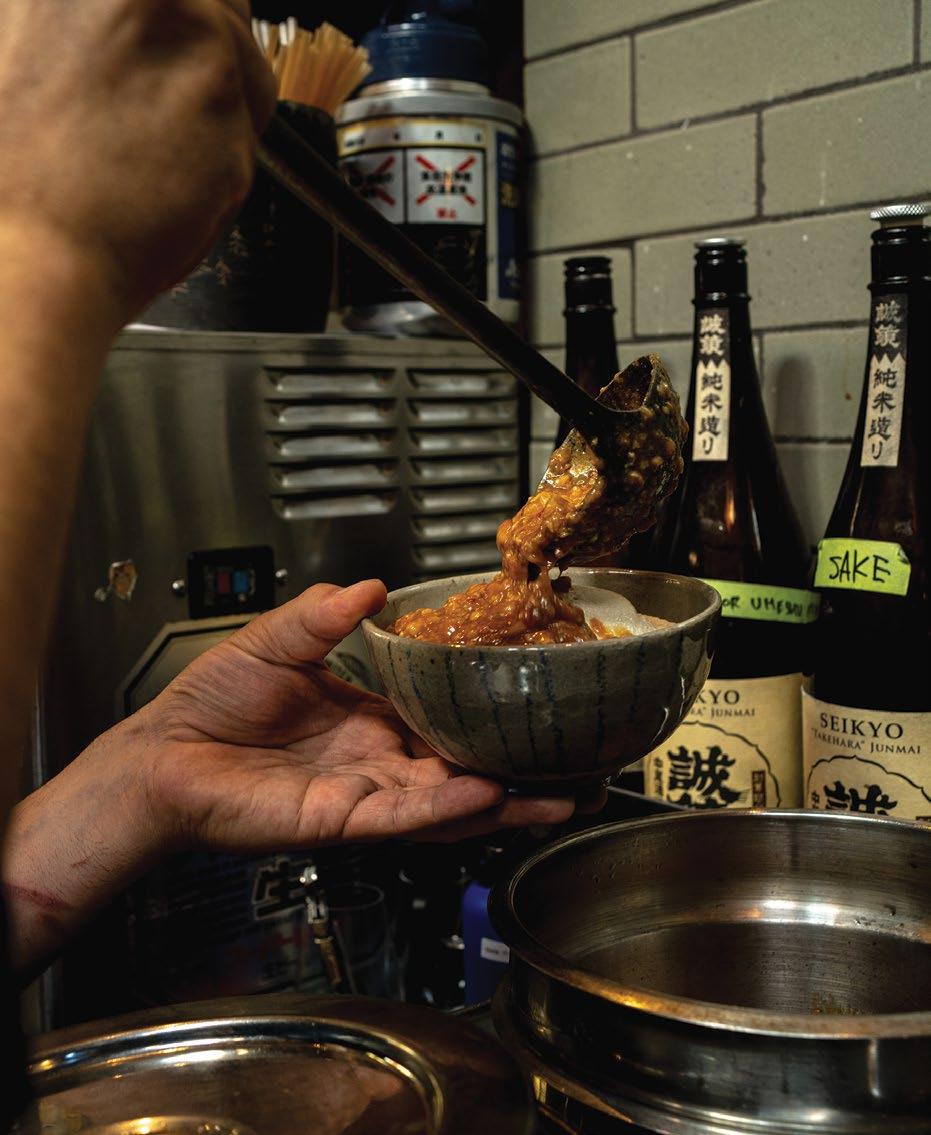
Cut the tofu into 1-inch/2.5 cm cubes and gently place in a bowl; add hot tap water to cover.
Heat the vegetable and sesame oils in a wok, 12-inch/30 cm cast-iron pan, or large Dutch oven over high heat until the oil starts to shimmer. Add the ginger, garlic, and chiles and saute for a few seconds until fragrant. Add the pork, break it up with a wooden spoon, and continue to cook over high heat until the meat has begun to brown. Decrease the heat to medium and add the onion. Cook until the onion becomes soft and translucent, about 7 minutes. Add the miso, sugar, tobanjan, black pepper, and chicken stock. Bring to a boil, then turn down the heat and simmer for 8 to 10 minutes, or until the pork is tender. Gently add the cut tofu to the meat sauce and return to a simmer.
In a small bowl, mix the potato starch with 1/4 cup/60 ml cold water, and gently stir it into the mabodofu. Cook for another minute, until the sauce has thickened.
To serve, spoon hot rice into a large serving bowl and then gently add the mabodofu. Top with a pinch of ground sansho pepper and a mound of thinly sliced scallions.
Variation: For a secret crunch, mound 1 tablespoon tenkasu tempura bits (see page 225 in Rintaro) under the scallions.
They studied, created, traveled, discovered, played, led, and learned. Meet 12 members of the class of 2024 as they reflect on their time at Reed.
Photos by Daniel Cronin
Hometown: New York City
Thesis advisers: Prof. Geraldine Ondrizek [art] and Prof. Jay Mellies [biology]
Thesis: “Enfolding Liveliness: Invoking Bacteriophage Therapy for More-ThanHuman-Kinships”
What it’s about: My thesis used art and microbiology to investigate how using bacteriakilling viruses (phages) to treat human infections could inspire radical kinships between humans and microorganisms. I used research techniques to better understand phage-host relations and made a funky vest to reembody its wearer to include phages, connecting those practices with critical theory and anthropology.
What it’s really about: Do you want to join my microbiology cult?
Influential class: In Gerri Ondrizek [art]’s class Sculpture in the Expanded Field, I created artwork that activates the space around it. And Prof. Julia Michaels’ [biology] Restoration Ecology class inspired me to think critically about how humans can steward landscapes.
Groups or clubs: I spent the last four years improving my calligraphic abilities in the Scriptorium, which I put to use helping Gregory MacNaughton teach calligraphy and handwriting at local elementary schools. All while meeting weird alumni who brew beer or make brushes from roadkill fur.
Cool stuff: Square Ball, a square dancing ball with a live band and caller, is my pride and joy—I threw it three times! I also biked from Portland to San Francisco, sold my comics at the Zine Fest, and spent a lot of time at the KRRC radio station.
Influential book: Jamaica Heolimeleikalani Osorio’s Remembering Our Intimacies: Mo’olelo, Aloha ‘Aina, and Ea
In high school: The bowler hat kid, you know the type.
Challenges faced: Coming into Reed as a freshman in 2020 made developing relationships with the community and institution remarkably tough. Reconciling the kind, curious, and rascally spirit of the community with the increasingly suffocating realities of the institution has required dedication to seeking each other out.
Special projects: With the support of the Art Internship Award, I worked as a studio assistant for the organization Gather:Make:Shelter, which supports artists in Portland struggling with houselessness. I also spent a summer as a visiting researcher in the lab of Prof. Joan Steitz at Yale investigating structural RNA elements in transposons, which was supported by the Summer Opportunity Fellowship Award.
What’s next?: I’m working with the art professor Dr. Juniper Harrower as her studio/lab manager! Then probably a PhD in microbiology.
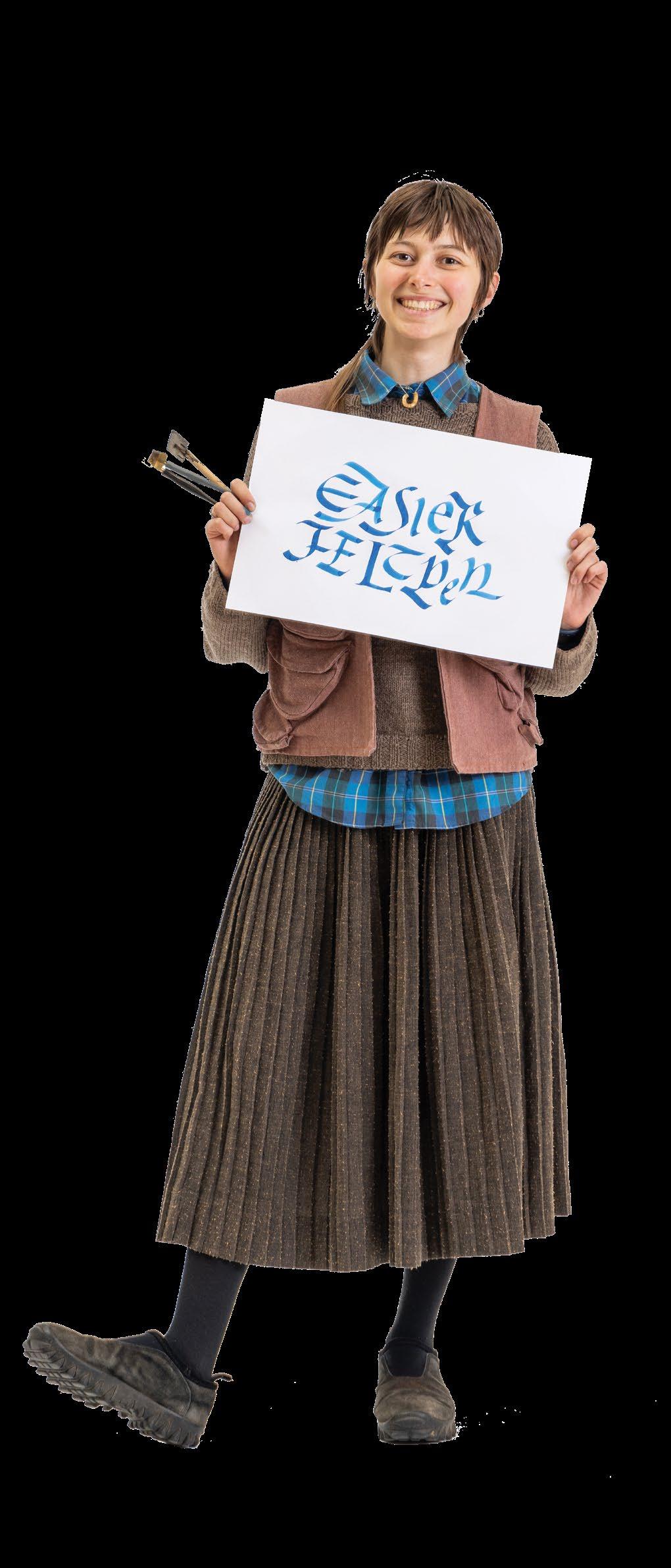
Hometown: Las Vegas, Nevada
Thesis adviser: Prof. Lindsey K. Novak [economics]
Thesis: “How Can Digital Advisors Cater to Loss-Averse Investors?”
What it’s about: How to distinguish loss-averse investors from risk-averse investors for digital advisers and designing investment strategy recommendations tailored to their distinct risk profiles and preferences.
What it’s really about: How can we personalize financial services using a robot adviser for people afraid of losing money?
In high school: I was curious and confident. My curiosity encouraged me to think deeper about how the world worked, physically and socially. My confidence allowed me to relentlessly ask my mentors in life those mind-boggling questions that I could not figure out on my own. This wombo-combo was my secret sauce in high school and is still applied today.
Influential Reed professor: Jon Rork [economics] is who I aspire to be. A polymath individual that breaks down complex problems of any topic into bite-sized servings that become easy to understand and digest.
Groups or clubs: Peer Mentor Program, Pool Hall, Reed Basketball Club, Reed Finance and Investment Club.
Cool stuff: First of many NBA games, white water rafting (highly recommend!), surfing on the coast, DJ DON RAFA was born, and zumba.
Influential book: Young’s ’16 thesis “Myopic Loss Aversion in Investment Behavior.” I found it influential not only because reading their thesis inspired my thesis but also because of the amount of work put on display when reading it. This showed me that the only limitations that can be placed on myself is myself.
Concept that blew my mind: Did you know that everything is a spring?!
Challenges faced: an academically challenging institution. I switched majors after pursuing physics for three years because I failed both attempts at the junior qualification exam, and I was no longer allowed to graduate from Reed College with a degree in physics. I overcame this obstacle by pivoting, persevering, and becoming a first-generation college graduate of economics.
How Reed changed me: reinforced my curiosity and confidence as the students, faculty, and staff created an environment that encouraged deep learning among our community of intellectuals.
Help received along the way: I was provided financial aid and that made my dream of going to college out of state possible! Reed College truly made my dream come true.
What’s next: change that I want to see in my community.

Hometown: Ojai, California
Thesis adviser: Prof. Sara Jaffe [creative writing]
Thesis: “Plans for an Amphitheater: A Novella”
What it’s about: It’s an experimental novella in three parts about a romance between three artists who work on an ambitious, collaborative project. I utilize different narrative genres (autofiction, prose poetry, scriptwriting) as the characters become closer and embrace a multimodal practice.
What it’s really about: Interdisciplinary art making, collaboration, queer desire, contingencies, active volcanoes.
Influential class or professor: Prof. Jae Yeun Choi’s [creative writing] the Poem Visualized course challenged me to reposition my relationship to words and semantic content via visually focused experimentations.
Cool stuff: Student Body Senate, Japanese Heritage Student Union, Herodotones a cappella ensemble, House of Elvira (student drag club, founded by my close friend Sienna Otero ’24), Reed College Creative Review.
Concept that blew my mind: Rhizomatic theory has such broad applications and encourages an expansive outlook that goes beyond literature and academia. I try to be multitudes every day!
Influential book: Writers Who Love Too Much: New Narrative Writing 1977-1997, edited by Dodie Bellamy and Kevin Killian. My thesis adviser pointed me to the anthology early into my project; it totally reinvigorated my approach to experimental and autobiographical writing.
Challenges faced: My class started at the peak of the pandemic, and not being able to interact freely with most students as an underclassman made it difficult to find the right friend groups and have the experiences that forge deep bonds. But each year brought new people into my life that made Reed a more warm and supportive environment.
How Reed changed me: Reed has made me more critical of assumed knowledge and approaches to problem-solving and creativity. I learned to be a more resourceful person by learning to maximize the resources and opportunities made available to students, such as summer funding or rentable equipment for personal projects.
Special projects: I was given the President’s Summer Fellowship award for a hybrid academic-creative project on “queer musical personas.” I researched a century’s worth of queer musicians with performative personas while creating my own persona for an original music project. This project allowed me to invest more deeply in my passion for music and queer world making and gave me the resources to pick up some technical skills like music recording and production.
What’s next: I will be working at Passages Bookshop in Northwest Portland, doing everything from archival research to hosting community events. I’ll also be doing drag and music performances, and co-hosting events for the Graft Union Reading Series, a crosscollege literary arts collective that my friends and I started in May.

Hometown: Fremont, California
Thesis advisers: Prof. Daniel Loya [chemistry] and Prof. Jay Mellies [biology]
Thesis: “From Bottles to Biodegradation: Investigating Crystal Polymorphism for Chemo-Microbrial Plastic Degredation”
What it’s about: To combat plastic pollution, my thesis focuses on optimizing the rate of PET plastic biodegradation by a plastic-degrading bacterial consortium using chemical methods. I’m looking at the effect of crystal polymorphism, or how molecules arrange in the solid state, on microbial degradation to make the entire biodegradation process even faster.
What it’s really about: Making plastic-eating bacteria a feasible route for plastic recycling (using chemistry)!
In high school: I was a band kid and a dancer, and spent lots of time looking up random things on Wikipedia (still do!).
Influential Reed class or professor: Community Dance (Dance 232) taught by Prof. Victoria Fortuna [dance]. Growing up as a dancer, I always thought of dance as a product-oriented experience, but taking Community Dance allowed me to enjoy the collaborative, creative process and gave me new insights about dance and movement.
Challenges faced: COVID was definitely a struggle during my freshman year, especially the isolation during quarantine. Despite the pandemic, I’ve been able to meet such amazing and wonderful people during my time at Reed that have made that tough first year worth it.

Hometown: Washington, D.C.
Thesis advisers: Prof. Jay Mellies [biology] and Prof. Gonzalo Campillo-Alvarado [chemistry]
Thesis: “A Codrug for Resistant Coinfection: The First Clinically Relevant Antimicrobial-Antiviral Ionic Cocrystal”
What it’s about: Antimicrobial resistance is a global health concern that researchers across scientific disciplines are trying to address. The approach I took in my thesis is called pharmaceutical cocrystallization, a technique that creates new multicomponent crystals (cocrystals) between pharmaceuticals and other FDA-approved compounds. With this technique, I cocrystallized an antimicrobial with an antiviral and tested its antimicrobial properties.
What it’s really about: Can I make crystals that treat bacterial AND viral infections?
In high school: I was the nerdiest and shyest basketball point guard.
Influential classes: Prof. Nicole James’s [chemistry] intro chemistry course and Prof. Gonzalo Campillo-Alvarado’s organic chemistry course. I had the honor of being in the first classes both professors ever taught at Reed, and as someone who hopes to teach someday, I was inspired by how deeply they care about making science accessible.
Extracurriculars: I was the head of the Whitewater Club at Reed, where I got students in kayaks to learn some whitewater skills and be silly and splash around.
Cool stuff: I became a published researcher my senior year in the CampilloAlvarado group, with publications in the Royal Society of Chemistry and my first-author publication on its way to the American Chemical Society Crystal Growth & Design journal (Bicknell et al. here we come!).
Challenges faced: I had a very limited science education coming to Reed and felt deeply I didn’t belong in my science courses, that I had somehow faked everyone out. Becoming a tutor and building community around teaching and learning allowed me to shake these feelings and help empower others and myself to believe we belong in STEM.
Help received along the way: Reed’s financial aid tipped the scales for my attendance and made it all possible.
More cool stuff:
In winter 2022, the Frank H. Westheimer Student Research Fund for Chemistry gave me the opportunity to travel to Morocco and represent Reed at the Atlantic Basin Conference on Chemistry, where I presented my work on STEM education, mentored by Prof. Nicole James. I had always imagined becoming a scientist who got to travel the world, but to have this experience as a third-year undergraduate was mindblowing.
What’s next: This summer, I will stay on at Reed as a post bac to turn my thesis into a journal article. After the summer is up, I’ll be working at Georgetown University as a research assistant studying what urate crystals can teach us about snake evolution.

Hometown: Palo Alto, California
Thesis advisers: Prof. Angélica Osorno [mathematics] and Prof. Adam Groce [computer science]
Thesis: “Categories for Cryptographic Composability”
What it’s about: In cryptography, we want to prove that computer programs are secure. In the real world, programs run in concert with many other programs, but these “composite” systems are generally too complicated to study mathematically. My thesis studies several applications of the mathematical field of category theory to this problem.
What it’s really about: Can we apply a field of math lovingly called “abstract nonsense” to facilitate proving that modern computer systems are secure?
In high school: I was an avid board gamer and reader, a competitive debater, and, honestly, a pretty inattentive student.
Groups or clubs: SL(m) (the math social group), CSTAR (the computer science social group), and the CS peer mentorship program. I also co-organized the math student colloquium and wrote the grading scripts we use to help grade students in Intro CS.
Cool stuff: I was a course assistant for over a dozen courses, including Intro CS for six semesters in a row. I also learned how to juggle!
Influential Reed class or professor: The most mindblowing 20 minutes of my life was the start of Prof. James Fix’s [computer science] lecture on the Curry-Howard correspondence. Informally, Curry-Howard is the idea that mathematical proofs carry computational content—any time you write a proof in math, you can interpret it as a computer program, and you can even “run” that computer program to learn about the proof. I added the CS part of my major because I wanted to keep studying that beautiful idea.
Influential book: Anna Tsing’s The Mushroom at the End of the World: On the Possibility of Life in Capitalist Ruins
Challenges faced: It was really hard to navigate starting college at the peak of the pandemic. I have health issues, so I spent two years in isolation, talking to people online and sitting outside at meals. I was really glad that, when I felt comfortable leaving isolation, I was able to make fantastic friends who I will hopefully be in contact with forever.
How Reed changed me: I’m more comfortable with my gender identity and a much more extroverted, social person.
What’s next?: Graduate school in mathematics at the University of Pennsylvania!
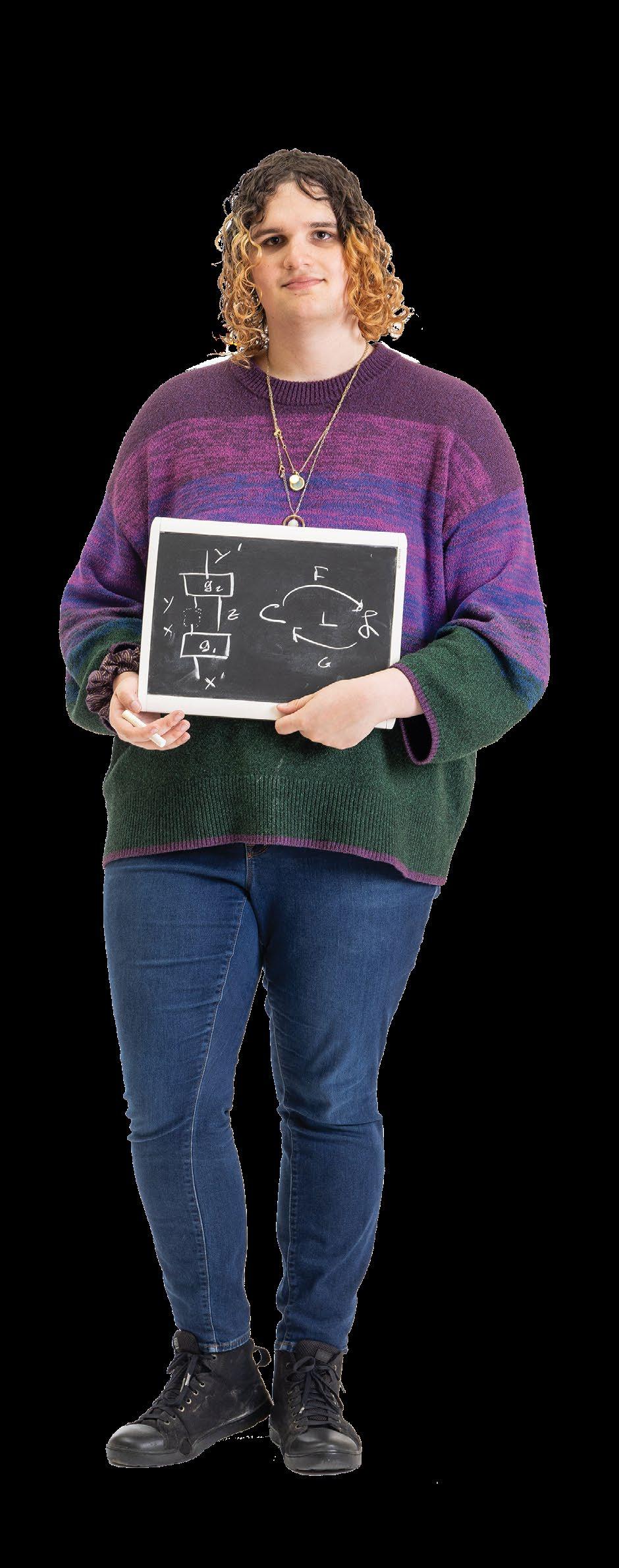
Hometown: Tigard, Oregon
Thesis adviser: Prof. David T. Garrett [history]
Thesis: “In the Company of the Marquis: Reevaluating the Collapse of the Aztec Empire”
What it’s about: My thesis analyzes how different 16th century groups in and around Mexico City thought about the destruction or collapse of the Aztec Empire. Conquistadors posit that they destroyed the Aztec Empire, while challenging claims from Indigenous authors state that a diverse set of Native groups contributed to its collapse as well. Each group wrote their chronicles to preserve their legacies and political power in Mexico.
What it’s really about: How groups in Mexico thought of the conquest varied drastically. Ultimately, understanding the conquest through conquistador eyes fails to capture its nuances.
Influential class:
Prof. Josh Howe’s [history and environmental studies] Introduction to American Environmental History class introduced me to historical inquiry and thinking. For my final research project, I delved into the Reed newspaper archives to understand how Canyon Day changed over the decades, which made me confident in my historical abilities. He’s also an incredibly supportive and down-to-Earth teacher! He even offered to write me a letter of recommendation with only two days notice!
Extracurriculars:
Every Thursday I would attend the Sobremesa, or after-dinner talk, and mingle with the Spanish Language Scholars. It was a great way to improve my Spanish and get closer to my discussion teachers!
Influential book: The summer after my sophomore year, I listened to 1493: Uncovering the New World Columbus Created by Charles C. Mann on audiobook while working in the library. After reading it, I checked out every book I could on the conquest of Mexico and ended up writing my thesis on it! As a graduating library worker, the library offered to buy a book in my name for their collection and I chose one about the conquest. Hopefully it inspires someone the way 1493 inspired me!
How Reed changed me: Reed has given me confidence in myself and the comfort of knowing that I can do anything! Writing a thesis was one of the most difficult things I have ever done, and now that I’ve finished it I feel much better about accomplishing anything I want in life. As a Reed student, you come in as iron and leave as steel.
Help received along the way: Reed gave me a lot of financial aid which allowed me to get an excellent education without worrying about the strain it would have on me and my family.
What’s next: In August I leave for the PeaceCorps to teach Spanish literacy in the Dominican Republic for two years!

Hometown: Irvine, California
Thesis adviser: Prof. Jennifer Sakai [art]
Thesis: “Control Liberate the Narrative: Black Liberation Through Re-Appropriations in Modern Art”
What it’s about: My thesis explores re-appropriation in the practices of six Black artists, who use this technique as a strategy for Black liberation. Their artworks examine the culturally appropriative westernization of African aesthetics, problematize the privileged styles and techniques associated with western canonical masterworks, and ultimately liberate oppressive narratives of Blackness.
What it’s really about: Why is it okay for a Black artist to copy Picasso but not okay for Picasso to copy a Black artist?
Influential class: Prof. Akihiko Miyoshi’s [art] experimental media class was the first time I feel like I was given space to fail in art. It allowed me to expand the predetermined limitations of my own creativity.
Extracurriculars:
I was student body president and served other roles in student government every semester at Reed except my last. I cochaired the Black Student Union, served on Honor Council, and mentored in our peer mentoring program, which was probably my favorite job of them all.
Cool stuff: I had a show on the radio station most semesters, which was a lot of fun. I’m pretty convinced my mom was my only regular listener, but it was nice to have an hour of air time to rant about movies and play some music (and receive texts from my mom responding to things I said on-air).
Influential book: If Beale Street Could Talk by James Baldwin. I’m not someone who cries very often, but Baldwin definitely made me shed some tears on the bus. It is such a heartwrenching story, but it also made me think of how few stories I could recount that were centered on the loving relationships that exist between Black people, whether it be through friendship, family, or romance.
Challenges faced: Reed was not always kind to me whether through implicit or explicit bias. Being student body president gave me a lot of solid avenues for advocating for myself and others when faced with institutional bias. But I think leaning on my support system was the only way I made it through all four years. I always had academic advisors who cared about my well-being (Profs. Kris Cohen [art] and Michelle Wang [art history] were truly the best), and they made it abundantly clear that they believed in my ability to succeed. And I’m lucky enough to be graduating with some really good friends who always helped me find joy in the tougher moments.
How Reed changed me: I’m a lot more confident now in my abilities. I’m more comfortable with the idea that one’s trajectory is not always linear.
Help received along the way: A lot of people have asked me why I chose Reed and my answer is always the same: financial aid. In the past four years, I’ve discovered several other reasons to choose Reed, but none of those really matter if you can’t afford to go here!
What’s next: I will be moving to London to pursue a graduate program in art history.
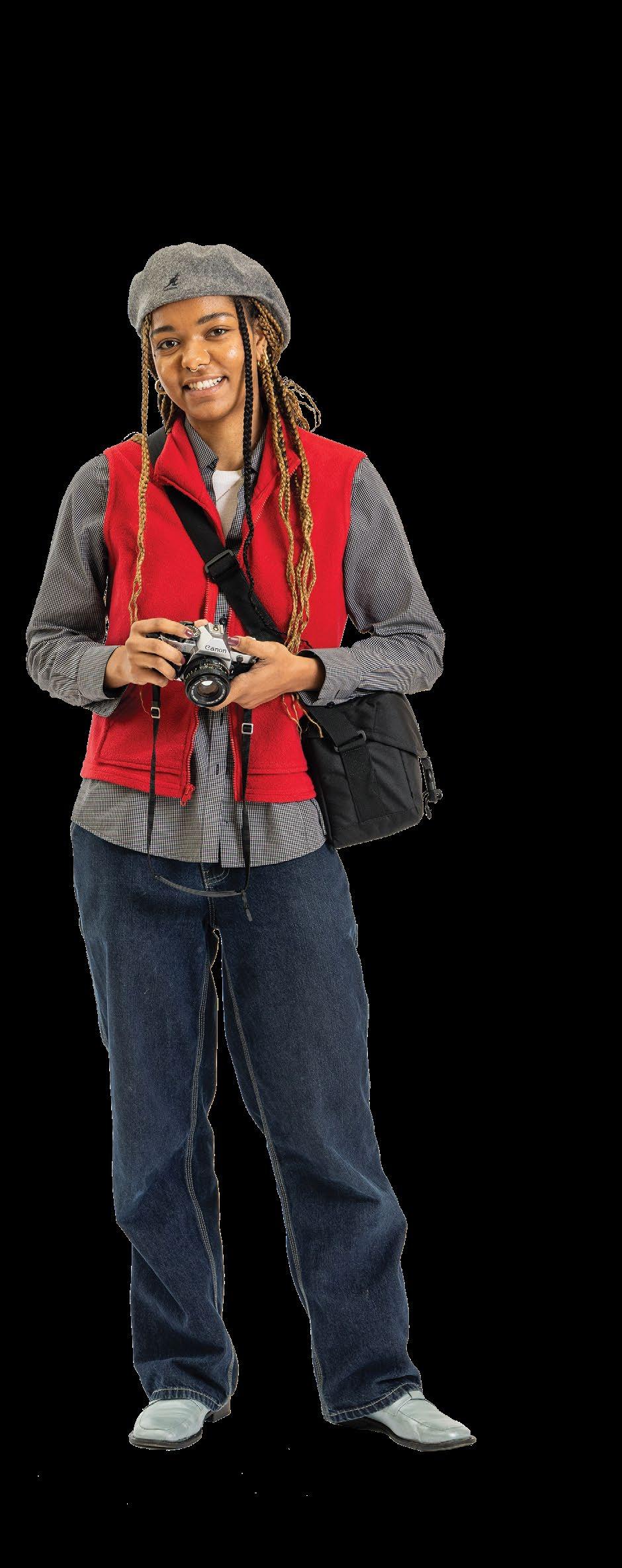
Hometown: Grants Pass, Oregon
Thesis adviser: Prof. Chris Koski [political science and environmental studies], who is the bomb.com.
Thesis: “Out of the Woods: Land Use Allocation and Timber Regulation Changes on Oregon and California Land”
What it’s about: I compare the land use allocations and timber regulations in the 1995 and 2016 resource management plans for the Bureau of Land Management in Western Oregon.
What it’s really about: How do we balance caring for the environment and caring for communities that have harvested timber for decades?
In high school: I was a competitive athlete with big hopes and an even bigger to-do list!
Influential Professor: Chris Koski’s assignments and lectures gave me permission to explore parts of environmental politics and policy studies I would not have normally.
Groups or clubs: I was the programming assistant for the Elections and Voting Information Center (EVIC), working on two surveys, a book, and many academic articles. I was also a barista at Paradox!
Cool stuff: I was the coach for a fifth grade girls basketball team, and helped out with a few clinics and camps for middle and high school players. I was also an intern for Senator Ron Wyden!
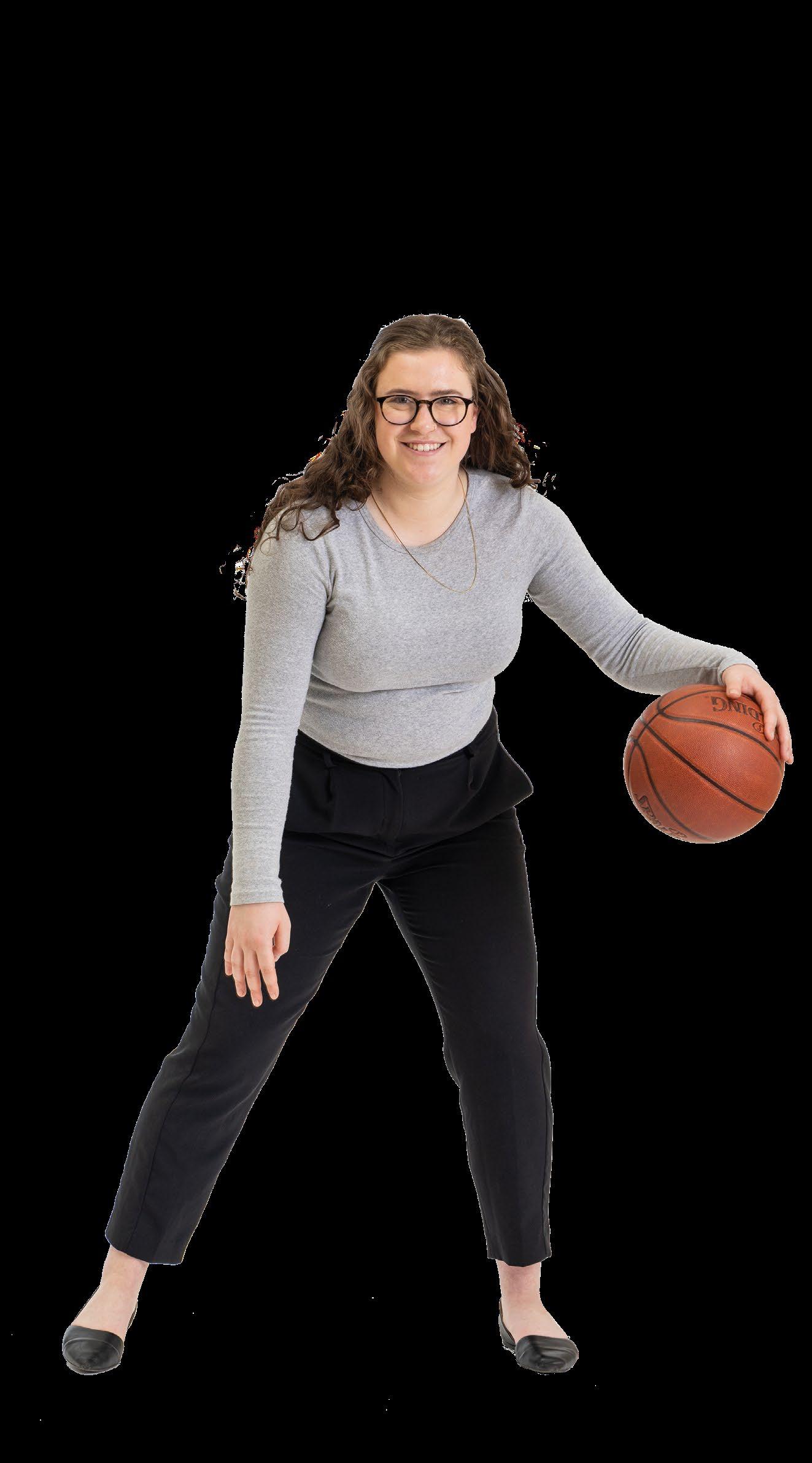
Hometown: Brooklyn, New York
Thesis adviser: Prof. Adrien Allorant [statistics]
Thesis: “Comparing Classic Parametric and Novel Machine-Learning Techniques to Analyze Survival Data: an Application to Historical PopulationBased HIV Surveys in Sub-Saharan: Africa”
What it’s about: Applying a statistical method from the high peaks of theory to a dataset from the far fields of applied public health.
What it’s really about: Learning more about risk factors for HIV.
Influential class: Prof. Hyong Rhew [Chinese]’s Early Chinese Philosophical Texts blew my mind. We read documents compiled two millennia ago, in a moment wracked by violence and famine. Watching humans stand and teach in the face of chaos was incredible.
Groups or clubs: Before COVID, there used to be a mathematics colloquium where students came together to hang out and listen to student talks about mathematical concepts. This year, we revived the colloquium and made uniforms for the math Renn Fayre softball team, which made it to the quarter finals!
Influential book: Zhuangzi. In the book, Daoist sages and students write about the difficulty of making sense of an inexplicable, terrifying, and beautiful world, the trust and acceptance that one must have in their own body, and the importance of wandering without a destination.
Awards, fellowships, grants: Reed College Science Research Fellowship, Economics Summer Research Program Fellowship, Phi Beta Kappa.
Special project: My economics research went to the heart of local politics. The Oregon Constitution has a kicker provision requiring the state to return tax revenues above forecasted amounts to taxpayers should a surplus exceed two percent. The government incurs the cost of returning excess funds, effectively punishing Oregon during windfalls. Working with Dr. Jon Rork and the North Star Civic Foundation, I lent credence to claims that that unpredictable swings in capital gains were a large factor in prediction errors. This project culminated in a presentation to the Oregon state economist and a publication of our findings.
What’s next?: I will be working as a Director’s Financial Analyst at the Consumer Financial Protection Bureau! I’m eager to learn more about the meat of the regulatory process—and excited to use my statistical knowledge as a tool to help humans.

Hometown: Denver, Colorado
Thesis adviser: Prof. Kristen G. Anderson [psychology]
Thesis: “So What We Get Drunk: Social Anxiety, Drinking Motives, and Drinking Outcomes in an Emerging Adult Gender Diverse Community Sample”
What it’s about: My thesis explores the impact social anxiety has on the reasons individuals choose to drink alcohol, and how these factors impact alcohol use outcomes. I explored these relations in a sample of gender-diverse emerging adults. I found that increased social anxiety is associated with increased endorsement of coping motives for use and higher rates of potentially hazardous drinking. However, the effect of gender remains unclear.
What it’s really about:
Social anxiety, drinking motives, alcohol consumption, and potentially hazardous drinking in a community living sample of emerging adults.
Extracurriculars: I was involved with the Jewish Student Union. Some of my favorite events included Spring Shabbat, Purim Ball, and Ball Mitzvah. At Ball Mitzvah I was lucky enough to DJ the event and had a phenomenal time bringing people together.
Cool stuff: Taught pigeons to gamble in Prof. Tim Hackenberg’s Learning & Adaptive Behavior Lab.
Concept that blew my mind: Reduced listening, which was coined by Pierre Schaffer. It is listening devoid of causality or meaning (and I am still not convinced it exists). It asks someone to hear sounds for just their sonic qualities and not what causes the sound, where it came from, or what it means.

Hometown: Kathmandu, Nepal
Thesis adviser: Denise Hare [economics]
Thesis: “Navigating the intersection of Faith and Finance: The role of Islamic Finance in shaping FDI decisions in Muslim majority countries”
What’s it about: When faith and finance do intersect, who is affected? My thesis looks at how Islamic financial principles affect where and how Muslim majority countries invest their money.
What’s it really about: Does god control where some people’s money is spent?
In high school: I was very similar to how I have been in college, just a big yapper obsessed with soccer, food, and gossip, though I’ve been told I was more mean which I’m going to blame on the teen age.
Influential professor: Fathimath Musthaq [political science]. I had some of my most spirited discussions in her 3-hour-long political finance courses and her classes really built my understanding of the global financial market and why it works (and doesn’t).
Cool stuff: I was primarily involved with two clubs. The first was the Reed Finance and Investment Club which needed a major rebuild at the start of the year. Being able to build a club back up to a point where the meetings we were having were engaging, intelligent, intentional, and always filled with treats (literally) is something I am proud of. The second was Reed Soccer Club (Reed FC) where I met two of my best friends, Walker and Asher, and we shared more than just some tackles on the field, COYG eh?
More cool stuff: I learned about agriculture and farming. I will not shut up about agriculture; there is something so deeply profound about irrigation methods and why we need to make sure land is used sustainably. I was able to work with the Oregon Agricultural Trust over an extended period of time and learned so much about agricultural supply chains, the importance of farming and how to make beer.
Influential Book: Million Dollar Whale, you have to read it to get a better understanding of how easily one man was able to scam multiple financial institutions and governments.
Concept that blew my mind: How a dollar is not a dollar and learning about the social meaning of money and special monies with Prof. Yalçın Özka [sociology] in my SOC 352 class.
How Reed changed me: I’ve been humbled—and rightfully so. I will always be grateful to Reed College for that.
Help along the way? Financial aid allowed me to come to Reed all the way from Nepal which by itself is a pretty big step. I’m not sure that I can just shout out one person that made it possible but to everyone from the financial aid office to admissions to CLBR and the donors that make financial aid viable, I am full of appreciation and gratitude to all of you.
Other awards: I received the summer internship award, the climate change research and education fellowship and the President’s Summer Fellowship.
What’s next? I’m moving up to Seattle to work in finance and definitely want to head to a post-graduate program at some point but beyond that let’s see.

Edited by Robin Tovey ’97

Maurice Isserman ’72 explores the deeply contradictory nature of the history of the Communist Party USA (CPUSA), a movement that attracted egalitarian idealists and bred authoritarian zealots. He reveals how party members contributed to struggles for justice and equality in America even as they championed a brutal, totalitarian state, the USSR. (Basic Books, 2024)

Cecelia Burokas MAT ’68 published her second book, a collection of 15 intertwined tales that span four decades in which two very different families discover each other and make sense of their until-now separate worlds. Her previous book was Working in the Dark: A Memoir with Parrots. (WOW!Press, 2024)

Daniel Wickberg ’82 examines modern thought and thinkers from 1860, when Origin of Species was published, to the end of the 20th century. His focus is on the destabilizing effects of modern challenges to notions of fixed order and absolute truths, and the contradictory consequences for philosophical, political, social, and aesthetic thought. (Routledge, 2024)
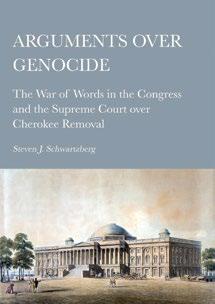
Steven J. Schwartzberg ’84 tells the story of the fight against Cherokee Removal and the ways that its justification continues to determine current law, policy, and conduct. He posits that the arguments in opposition to that genocide might be resurrected to transform American relationships with peoples of the Native Nations. (Ethics International Press, 2023)

Author and garden educator
Dan Rubin ’68 offers a collection of tips and techniques for gardening in northern, colder climates, based on his personal experiences when he moved to Newfoundland from the Gulf Islands of British Columbia. The illustrated book provides advice for Canadian gardeners, as well as anyone facing similarly challenging growing conditions. (Boulder Books, 2023)

To the framers of the Constitution, political parties were a fatal threat to republican virtues, and yet they emerged even before the document was ratified. This history of the early years of the republic by H.W. Brands MALS ’79 follows how the Founding Fathers fought one another with competing visions of what our nation would be. (Doubleday, 2023)

Ryan Moran ’03 examines how Japanese life insurance companies used the discourse of community to commodify and govern individual lives. Covering 1881 through World War II, he describes the machinations that cast the future as precarious and dangerous with intent to manage the crisis that accompanied Japan’s expansion as a capitalist nation-state. (Cornell University Press, 2024)

TH Lehnen ’08 has written a young-adult fantasy about growing up too soon, about found family, and about hope. A debut book that asks “Why do we grow more scared as we get older?,” it has been called “a novel for readers who enjoy rich worldbuilding in the style of Hayao Miyazaki.” (Aspen & Thorn Press, 2024)

Imagine “tangerines and apples stained with strawberry pink” alongside “white grapes covered with a silver bloom” as part of a decadent spread and try not to salivate. Katherine Mansfield created these vivid descriptions in her short story “Bliss,” but it is Elizabeth Blake ’04 who uses them to set the table for an exuberant conversation about desire, gratification, and embodiment in her first book, Edible Arrangements: Modernism’s Queer Forms
An assistant professor of English at Clark University in Massachusetts, Elizabeth sets out “to demonstrate how writing about eating can both unsettle the norms of bodily pleasure and those of genre itself,” yet this is not a dyspeptic look at modes of consumption. It is a joyous exploration of texts that convey the pleasure of eating while also pushing against or reshaping formal constructs of style. She analyzes “an abundance of edible imagery” and how it functions to illuminate sensory experience as well as how such representations can transform narrative conventions.

women’s literature to consider how eating can subvert notions of propriety, beauty, and status; in another chapter, she shows how feeding can be a means of nurture or a mode of control. Elsewhere, she goes beyond Rabelaisian tropes to argue that satire and obscenity, when “animated by queer gustatory pleasure,” can compel readers to acknowledge their own appetites (and their responses to them).
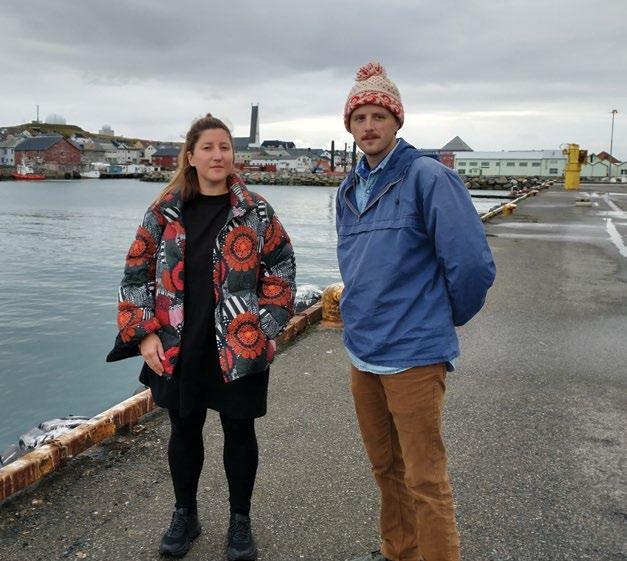
Composer John Andrew WilhiteHannisdal ’13 has a new project: recording, studying, and making music with cod fish. He and his crew have been working on this endeavor for six years and will be showing it at Nordic Music Days in Aberdeen this fall. Atlantic cod populations are down to the lowest levels ever, and John Andrew is hoping to use his scientific-artistic findings to change international policies about noise pollution, which prevents successful cod mating.
John Andrew and Canadian scientist Rebekah Oomen (pictured above) have proved that cod mating selection is determined by what kind of music the individuals make, evidence they can present to policy-makers.
In one chapter, Elizabeth looks at scenes of refusal and ambivalence in
This dinner party brings together Barthes and Benjamin with contemporary theorists like José Esteban Muñoz and Sara Ahmed. Freud and Foucault figure into discussions of disruption and critique, joined by Langston Hughes and Djuna Barnes, author of the 1936 novel Nightwood Novels by Richard Bruce Nugent and Virginia Woolf “theorize a sensibility of otherness” that functions to resist systems of aesthetics and gastronomic taste. By enriching our literary palate in this era of regulated behaviors, Elizabeth serves the most piquant insight of all: “. . . embracing the ordinary fact of being ‘very fond of eats’ might, in fact, be a little queer.” —Robin Tovey ’97
Check out their live performances with percussionists, in pieces composed according to the patterns of cod mating rituals, as well as performances with surreal floating fishlike sculptures on YouTube and Vimeo.
Lynette Yetter MALS ’21 finished an experimental feature film, Panpipes for Peace (available on YouTube) that was 15 years in the making.
Neal Goren ’79, founder and artistic director of Catapult Opera, conducted a new orchestration of La Ville Morte for its premiere at NYU Skirball in April.
A play created and performed by Devon Wade Granmo ’06 and Stephen Bron called Cave Play premiered at the Brick in Brooklyn this past April. Another of their works, (untitled human composting play), premiered at the Exponential Festival in 2023.
Edited by Joanne Hossack ’82


1954
Marvin Lehr sent this note in June, just before his 70th reunion: “Fellow classmates of ’54: Congratulations to those of you who could make it. My spirit will be with you, but not my body, because I would never miss my great-grandson’s second birthday on June 9. I live alone in my own home, but family live close by up the hill. I drive and do whatever else has to be done, except for housecleaning, which I hired two women to do. I’m an avid gardener, having created three xeriscape gardens around my house since 2020, and I’m working on the fourth. I still enjoy stamp collecting (82 years) and occasionally give talks on the technical aspects of the printing of old stamps. Good luck to you all.”
1955 70TH REUNION
Fall: the season when leaves fall from trees; autumn.
1956–62
The season between summer and winter,
1963
Bernie Dickman is “still alive, still retired, still enjoying gardening, playing clarinet, volunteering, working puzzles (won the NPR puzzle contest twice; due to win again in 2035. :))”
1964
Jim Kahan writes, “60 years out, I continue to strive to make a difference, occasionally getting myself into good trouble. I don’t publish as much as I used to, but still get occasional things out there in respectable outlets. I work with local groups on things as varied as realistic police reform, passing on a love of chamber music (performing and listening) to future generations, and making myself useful on campus. What time remains is for family, friends, and travel.”

1965 60TH REUNION when apples ripen and fall from trees
1966
(but they don’t fall too far)
1967
John Cushing was knocked flat by two large dogs running in tandem at Hollywood Dog Park in Portland. He awoke with a mouthful of sand. Then he laughed. Sheila Klatzky is celebrating her new status as a grandmother to a grandchild born this June!
1968
Cecelia Burokas MAT recently published her second book, Perfection and Other Stories, with WOW!Press.
1969
Bill Roberts wrote us in March, “I’m still alive and doing well, which is an accomplishment at my age, and one for which I’m properly grateful. My wife of 34 years, Lori, will

retire at the end of June, and we look forward to spending more time hiking and visiting our children. I still occasionally review articles for the Canadian Journal of Behaviour Science, which I edited from 2014 to 2017; but mostly I write letters to friends and enjoy walking paths in this beautiful part of the world. I feel so fortunate to have been carried to Canada by the tides of fate. But I am sad every day for the state of America.”
1970 55TH REUNION
(and if you sit in the right place, maybe some will fall into your lap!)
1971
In February, Douglas Fenner was part of a group that surveyed coral reefs in a bay in American Samoa that is part of a National Marine Sanctuary there. The group did 16 scuba dives, including 4 dives one day. In March Douglas did something similar with a group in Fiji; they did 20 dives on about 10 islands, from a live-aboard dive boat. Douglas went as deep as 115 feet. He notes that Fiji has 300 islands.
1972
Maurice Isserman has a new book, Reds: The Tragedy of American Communism. (See Reediana).
1973–74
Fall is when nuts, too, fall from trees
1975 50TH REUNION and squirrels squirrel them away.
1976
Georges Van Den Abbeele has published a book on French philosopher Jean-Luc Nancy, whom he first encountered when Nancy was a visiting speaker at Reed.
1977
Cecilia Eng performed a 30-minute singer/songwriter set at the Seattle Northwest Folklife Festival in May. Cecilia has been a singer/ songwriter since 1984 and was
inducted into the Filk Hall of Fame in Ontario, Canada, in 2013. In 2022, she won two Pegasus Awards, for Best Classic Filk Song, “Helva’s Song,” and for Best Writer/ Composer.
Long update (greatly condensed) from Chip Zukoski, who married Barbara Morgan two years after graduation. Chip spent a career (28 years) at the University of Illinois in Urbana-Champaign, teaching chemical engineering and conducting research in the area of suspensions; serving as department head and vice chancellor of research (he helped develop the research park and established the Institute of Genomic Biology); and, with Barbara, raising two boys. After Illinois, Chip and Barbara spent three years in Singapore working for the Agency for Science Technology and Research. Next, Chip served as provost at the University at Buffalo and the University of Southern California; after beginning to “rematerialize as a faculty member” in 2023, Chip took on another provost position, for NEOM University in Saudi Arabia, a start-up comprehensive research university that will open in 2029 as an anchor tenant of the linear city THE LINE. Meanwhile, Barbara, after working for what she deemed the military industrial complex, moved to working remotely for the family business, David Morgan, a mail-order business selling hats, leather goods, and jewelry. Not quite ready to face the exigencies of biology, Barbara and Chip continue to build university communities, hike and camp (the mountains around NEOM are stunning), and dote on grandchildren.
1978
Fall: to hang freely
1979
In preparation for his 50th high school, 45th college, and 40th law school class reunions, Kelly Doyle has become an Episcopalian, decided to run for Portland City



Council Position 4 (forming campaign Ohana) and shaved his face (no pictures for that yet).
H.W. Brands MALS has published a new book, Founding Partisans: Hamilton, Madison, Jefferson, Adams and the Brawling Birth of American Politics. (See Reediana).
1980 45TH REUNION
“Her hair falls over her shoulders.”
1981
Fall: a usually long straight portion of hair that is attached to a person’s own hair

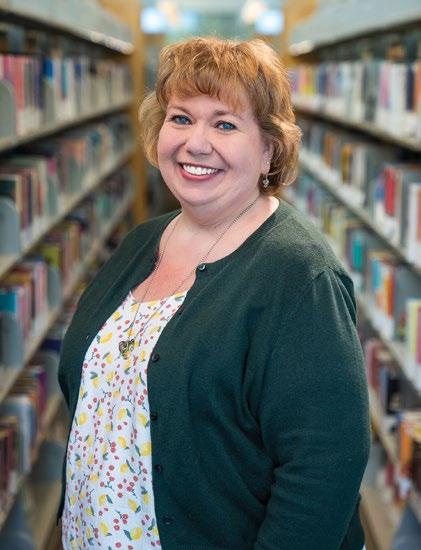

1982
Daniel Wickberg has published a new book. (See Reediana.)
1983 (and may fall over a person’s shoulders).
1984
In May 2023 Marianne Colgrove retired after many years in Reed’s IT department. “I felt so lucky to have worked my whole career supporting amazing faculty, staff, and students with whatever they were working to accomplish. Now I am enjoying part-time work for the Northwest Academic Computing Consortium, a nonprofit consortium that facilitates collaboration amongst higher ed IT organizations. And I especially enjoy coming back to campus for calligraphy Scriptorium, library books, and a stroll through the beautiful canyon trails. I’m looking forward to my 40th (!!) reunion,” she wrote in April. (Welcome to the FosterScholz Club, Marianne!)
Steven Schwartzberg ’s book Arguments over Genocide: The War of Words in the Congress and the Supreme Court over Cherokee Removal, published in 2023, is now out in paperback.
Aelyn Spaeth has gone through a few changes.After graduation, she
had a nearly 30-year marriage and an over-30-year career in IT at law firms, as a consultant, and at HVAC contractors—all without leaving Portland. During the pandemic and working from home, Aelyn began transitioning. She’s now retired and is a classical/operatic singer studying with two voice teachers.She performs regularly at Mendelssohn’s classical bar on North Mississippi Avenue in Portland and had her operatic stage debut last June.
1985 40TH REUNION
Paula Scott wrote in March, “ I am still married to Jean-Laurent Rosenthal ’84 . We had our 34th wedding anniversary last December. It seems like a very long time ago that we first met on the steps of the library at Reed! He still studies the French economy while being a professor at Caltech in Pasadena. I have been working as a professional organizer part time and volunteering as I have for many years in several community organizations. We will be at the Reunion for the first time since each of us graduated this June and are looking forward to it.”
Liisa Sjoblom was recognized with the Oregon Library Association President’s Award for her ongoing efforts to support opportunities for people to connect, future leaders to grow, and libraries to thrive.
Fall off the radar: to become less noticeable or less active; to lose prominence or attention.
In February, during a fast trip to Seattle, Tonio Andrade looked up two old friends, Jeff Bradford and Garth Kahl. “We’d originally met in McKinley dorm, and with better timing, we might have gathered two other Seattle-area dormmates, Chris Fast and dorm mom Cathi Hunt ’88 . It would have been a mini McKinley reunion! Any other late 1980s McKinley residents out there? I have such great memories of our time there.”
Don’t fall off the radar! Send your class note in now!
Neil Schulman is working to remove Kellogg Dam, which has blocked fish passage since 1848, and restore Kellogg Creek in Milwaukie, Oregon. Neil writes, “In addition to being a great project, it involves working with Reed alums Christine Lewis ’07 and Liz Perkin ’04.”
1993
Lynn Tesser ’s second book, the product of eight years of work, was
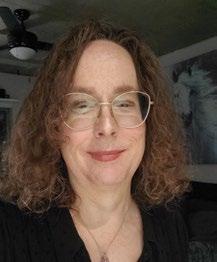
1. Kelly Doyle ’79 has converted to Episcopalianism (but we don’t know about his friend).
2. Once again Liisa Sjoblom ’85 is an award-winning librarian!
3. Left to right: Former McKinley residents Tonio Andrade ’90, Garth Kahl ’90, and Jeff Bradford ’90 reunite in Seattle.
4. Aelyn Spaeth ’84 has gone through some changes.
published this year by Stanford University Press. (See Reediana.)
Because writing a class note is as easy as falling off a log!
1995 30TH REUNION
So fall to it!
1996–97
Don’t let it fall through the cracks!
1998
Sarah Silkie is running for Portland City Council in District 4, which includes all of Portland west of the Willamette and the Sellwood, Eastmoreland, and Reed neighborhoods. “This is my first time running for elected office and I am having a lot of fun meeting people and learning all about our local government. I have been working for the city for the last 12 years protecting our drinking water and am excited to bring that frontline employee perspective and my scientific background to our local government. In preparation, I went through the Oregon Labor Candidate School, graduating in February. I’m still working my engineering job at the Water Bureau, but evenings and weekends you’ll find me around town learning about the issues and advocating for policy solutions.”
Congratulations to Sienna Shiga on her recent promotion to associate principal at Hacker Architects! Sienna’s interest in the built environment spans many project types and scales. Since joining Hacker in 2021, Sienna has contributed to projects requiring extensive community engagement, including the Skagit Valley College Culinary Arts and Library Commons in Mount Vernon, Washington, and the Center for the High Desert Museum Expansion in Bend, Oregon.
Eleanor (Roper-Ater) Bailey has repatriated after 20 years abroad and is excited to reconnect!
After three years as a visiting assistant professor at Reed, Paul Manson has joined the Center for Public Service at Portland State University as a research assistant professor. “I will continue my election administration research along with public opinion research on climate change. I am excited to reengage local and state government challenges at PSU. The center provides applied research support to communities, and I will manage a number of these engagements to support Pacific Northwest communities. On the home front the kids are big and soccer is happening all the time.”
Q magazine names the Fall one of “50 Bands to See Before You Die”.
Ryan Moran recently published his first monograph with Cornell University Press. (See Reediana.)
In 2022, after nearly 20 years in journalism, Emilie Raguso launched her own news site, the Berkeley Scanner, covering public safety in Berkeley and Alameda County. In 2024, Emilie won a National Headliner Award for online local news reporting as well as a “Truth to Power” press freedom award from the Northern California chapter of the Society of Professional Journalists for her coverage of the Alameda County DA’s office.
Congratulations to Amy Subach, who recently graduated magna cum laude with Lewis & Clark Law School’s class of ’24. She also visited Lindsay Fuchs Reilly ’05, Marian Macindoe ’02, Claire McCabe ’02, and Camas Goble ’02 in Oakland, California. Amy’s article on medical aid in dying and Alzheimer’s disease and related dementias will
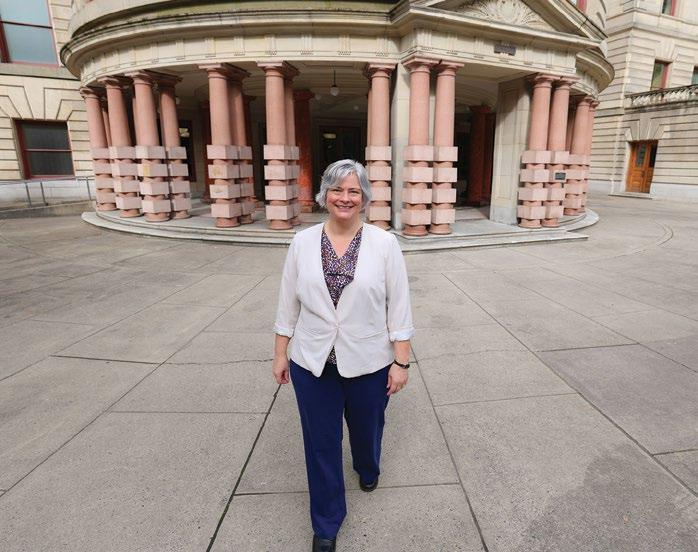
be published in the Lewis & Clark Law Review this fall.
Let the chips fall where they may:
To be having so much fun writing your class note that you drop all your tortilla chips on the floor and don’t even notice until the dog comes around to clean them up.
In July 2023, Devon Granmo joined the staff at La MaMa Experimental Theatre Club in the East Village. He performed his show untitled human composting play at Brick Aux in November.
Reedies including Ari Leventhal, Robin Fink ’09 , Matt Davidson ’06 , and Philippe Flamingo ’19 (whose Reed credentials we were unable to verify) met up for the eclipse totality in Dallas, hosted by Becca Embler ’06
T.H. Lehnen believes that young adult and children’s literature is simply more honest about the magic in the world. Under Aspen & Thorn Press, he writes young adult fantasy for children who are old souls, and
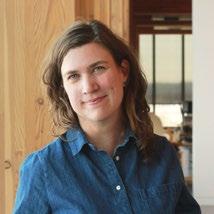

3. Emilie Raguso ’03 won a “Truth to Power: Golden Sledgehammer” award for her coverage of the Alameda County DA’s office.


old souls who are children at heart. He lives with his family in Portland, and studied creative writing, philosophy, and English literature at Reed. When he is not writing, he is tinkering with machines mechanical and digital (though he has yet to figure out how to fit a sports car through a wardrobe). His debut YA fantasy novel, Fog & Fireflies, was published in April.
2009
And maybe not even then.
2010 15TH REUNION
Because it is so much fun writing a class note
2011–14
that you will fall out laughing
2015 10TH REUNION so fall to it!
2016
Lots to chirp about for Wren Vetens: “Finished my PhD, and got a new job!”
2017
Aaron Ramcharan noted with a recent gift: “I am deeply thankful for Reed and intend to remain involved with it for my entire life. Recently, my law firm agreed to host an admitted students’ event
with the Reed admission office. That’s a major milestone and I’m quite pleased to be involved. . . . I’ve actually completed two law degrees since finishing Reed, one in the U.S. and one in the U.K., including a specialist degree in climate change law, the main area in which I work, along with the law surrounding air quality and global sustainability. I couldn’t have done either degree without Reed, and I wouldn’t be so well positioned to be working as a lawyer in arguably the most cutting-edge issues facing our world today without the deep, rigorous, and fulfilling education I received at Reed.” Thanks, Aaron!
Viva Las Vegas! Alex Grant and Francisca Garfia ’17 celebrated their wedding with friends from the class of 2018 at the Little White Chapel.
2019
As you leaf through this magazine, the leaves fall from the trees
2020 5TH REUNION and we leave you with this proverb:
2021
Liz Mastrangelo ’13 sent us some rugby intel: “Just a heads-up that Leila Shokat is headed to the touch
rugby world cup competing for Team USA this summer (as well as some other Reed-affiliated athletes like Claire Lundy who coaches the Reed-LC rugby club). And Rachel Johnson, who attended in 2009–10 and coached at Reed for many years, just captained the USA Eagles in Rugby Union against Canada and South Africa; she plays professionally in the UK now.”
Lynette Yetter MALS has been traveling the U.S. presenting at conferences, doing readings, and signing books after learning her bilingual book, Adela Zamudio: Selected Poetry & Prose, was a finalist for the 2023 PEN Award for Poetry in Translation. The book grew out of Lynette’sMALS thesis, Domination and Justice in the Allegorical Story “La reunión de ayer” by Adela Zamudio (18541928), Bolivia. Lynette is thrilled that Kirkus gave a starred review of the book, and BookLife named it an Editor’s Choice. Also, Lynette finally finished her experimental feature film Panpipes for Peace, 15 years in the making. You can see it on YouTube.
A [R]eed[ie] before the wind lives on, while mighty oaks do fall.
1. Waiting for the sun: Eclipse watchers Matt Davidson ’06, Becca Embler ’06, Phillipe Flamingo ’19 (?), Robin Fink ’09, and Ari Leventhal ’07.
2. Alex Grant ’18 and Francisca Garfia ’17 celebrate their wedding with friends from the class of 2018 at the Little White Chapel in Las Vegas.
Edited by Bennett Campbell Ferguson
Donald Green
’54 and ’04
March 7, 2024, in Jerusalem, Israel. When Donald Green protested pork-barrel politics by refusing to turn in his economics thesis in 1954, he appeared to be finished with Reed. Yet in 2004, following a career as one of the nation’s most prolific economists, he returned to the school that shaped him, writing a thesis about the Presidio of San Francisco and graduating before his 72nd birthday.
Born in San Francisco on August 15, 1932, to Stanley and Edith Green, Don first attended Reed at a time when the term “Reedie” had yet to be coined. He thrived there, and forged friendships that would endure throughout his life.
By his senior year, Don was facing academic and personal turmoil. He believed his thesis, a cost-benefit analysis of water resources projects, would have no impact, since legislators tended to approve dams in other districts in exchange for dams in their own. And to make matters worse, Don’s ex married his best friend. “I was struggling with life, love, and the pursuit of happiness; perhaps even some parental resentment—who knows?” Don told the Quest in 2003.
In 1954, Don’s parents arrived for graduation and were greeted with a surprise: Owing to his conviction that his thesis didn’t matter, their son had decided not to walk at graduation as an act of protest. “He told them then that he was not going to graduate and he would never graduate because he refused to turn in his thesis,” says Don’s cousin, Misha Isaak ’04.

“Instead of going to graduation, his whole family went on a rafting trip [on the McKenzie River].”
Don spent the summer after he had intended to graduate working for the Fish and Wildlife Service in Alaska—keeping salmon fishermen away from the mouths of salmon-spawning streams—but found time to revise his thesis, write poetry, and pen letters to Reed pals and old girlfriends.
By 1955, Don had completed his MA in economics at the University of Chicago, which did not require a BA. He subsequently volunteered for the army to avoid the draft, teaching economics to air force personnel in France and enjoying Europe, he cheekily later said, “at Uncle Sam’s expense.” In 1959, he married Joan Green
(née Friedman) in La Paz, Bolivia, where he worked for the Foreign Aid Agency.
Don went on to study compensation for the Tlingit and Haida Indian Tribes and serve as head of the international economics division of the Federal Office of Management and Budget under President Johnson. After retiring in 1993, he advised small businesses in Russia (as an arbiter of the National Association of Securities Dealers) and opposed commercial development at the Presidio, the former military base in San Francisco that had become a national park.
projects that the Trust initially proposed. His battle to save the Presidio spurred his return to Reed, where he would fulfill his remaining graduation require-
The Reedie who returned to write what was hailed as “a thesis 50 years in the making.”
ment by writing a thesis about the first six years of the trust— inspired by his cousin Misha, who was then a Reed student himself.
Allied with neighbors and environmental groups, Don convinced the Presidio Trust to develop a master plan for the entire park, thwarting the development
“I said to him, ‘Well, why don’t you graduate now?’” Misha recalls. “He thought this was a fun idea. It was a perfect match for Don’s wry sense of humor.” Work on Don’s thesis, “Principal Agent Theory: Case Study of the Presidio Trust,” began in October 2003 under
Prof. Denise Hare [economics].
“He was willing to come to us on our terms and say, ‘What is expected today of an academic thesis in economics?’” she says. “He didn’t write a 1954 thesis. He wrote a 2004 thesis.”
While writing his thesis, Don flew back and forth between San Francisco and Portland. He graduated in 2004, earning the economics BA he had walked away from in 1954. “Everybody in the graduating class was well aware that among the graduates, there was an old man who was my cousin who was graduating with us,” Misha recalls. As Don crossed the stage, he was heralded by raucous applause.
Whether he was participating in a European sojourn for alumni or lending his pipes to a musical celebration of Reed’s first 100 years, Don remained a part of Reed. “He loved the rigorous intellectual environment of Reed—which was true of Reed when he was a student there, was true of Reed 50 years later when I was a student there, and is true of Reed today,” Misha says.
Don and Joan attended Congregation Emanu-El in San Francisco for 45 years, and in 2022, they moved to Israel, where Don spent the final years of his life. He is survived by Joan and their sons, Mark (Green) Solomons and Aryeh Green. Family members remember him for his intelligence and wit, which helped define his legacy as the Reedie who returned to write what was hailed as “a thesis 50 years in the making.”
“The whole story sort of encapsulates Don’s personality—his humor, his sharp wit, his brilliance, his love of learning,” Misha says. “It’s a lovely story to reflect on now that he’s passed away.”
Rosemary Lapham Berleman ’48
July 13, 2013, on Lopez Island, Washington.
It was a stormy night in January 1925 in Eastern Oregon when Ray Lapham ’19 bundled his laboring wife, Pearl, into their old car to drive her to the nearest hospital. Dudley Lapham ’43, five years old, helped get the family’s Model T Ford going. The headlights gave out at one point, and Ray had to strap a flashlight onto the grille for the rest of the journey. Thirty long mountain miles later, Rosemary was born in Burns, Oregon.
Rosie’s young life was spent in Eugene and Walla Walla, where Ray was either working on advanced degrees to become a literature professor or working as one at Whitman College. His love of teaching led the family to settle in Portland, where Rosie and her brother, known as Six, attended Reed College four years apart.
Rosie started there in 1943. She married Les Thompson ’50, with whom she had a son, Gregory, and they lived in the off-campus, student-run house at 1414 Lambert Street, the home of Beat Poet legends Gary Snyder ’51, Phil Whalen ’51, and Lew Welch ’50
Although Rosie did not graduate, she took many classes and embodied the Reed spirit of open-minded learning. In her unpublished autobiography, she wrote, “We were taught to open our minds to all opinions and not to make judgments without studying exhaustively all sides of a question.” She added, “And though I found out quickly that Reed wouldn’t magically turn

me into one of the 20th century’s great thinkers, I know that enough of those precious drops [of learning] entered my bloodstream to sustain me all my life.”
Reed gave Rosie her lifelong love of intellectual pursuit, along with friendships and loves that sustained her. After she and Les divorced, she married another Reedie, Bill Berleman ’53 , and followed him to Seattle, where they had two daughters while Bill worked as a professor of social work at the University of Washington.
When that marriage ended, Rosie lived with Fred White ’50 on the Oregon coast in Bandon
for some years, where the couple took part in many community theatre projects together. After that, she and Lyle Jones ’44 reconnected after having dated at Reed. They traveled together and remained close friends until Lyle’s death in 2016.
Two notable highlights of Rosie’s career were typing poems for Theodore Roethke when he was teaching poetry at UW in the 1950s and going out on a date with Jimmy Carter while she was working as an administrative assistant in Portland after WWII. Rosie’s final partner was Bill Jennings
Baker ’50, who had been part of the Lambert Street cohort. They lived together near Portland until Bill’s death in 2018.
Rosie made her way to Lopez Island during the pandemic, where her niece Rosie Sumner ’73 and grandniece Madrona Murphy ’02 live. She passed away peacefully there in her 99th year, with friends and family keeping vigil. Rosie was preceded in death by two children, Greg Berleman and Mara Berleman, and is survived by her daughter, Kaija Berleman.
Tom Conway ’48 November 3, 2023, of pneumonia.
Thomas Conway was a vivid, enrapturing storyteller up to the day he died at the age of 100. With a life spanning many places and experiences, he had countless stories to tell.
Tom was born May 12, 1923, in Portland. He stayed in the area for his higher education, beginning his studies at Reed in 1941. His educational pursuits were put on hold when the United States entered World War II. For four years, Tom served in the U.S. Navy, mostly on a ship in the Pacific Ocean.
Tom graduated from Reed in 1948, completing his thesis, “An Attempted Determination of Inclusions in the Silver Coulometer Using Radioactive Sulfur,” under Prof. Arthur F. Scott [chemistry 1923–26, 1937–79]. He married his college sweetheart, Jeanette Henny ’52 , and the pair had two children, Robin and Peter, before moving to Mercer Island, Washington, in 1957.
After earning his master’s degree in education from the University of Pennsylvania, Tom taught at several school districts over the years, including chemistry at Mercer Island High School and math in the
Seattle, Lake Washington, and Bellevue school districts. He also coached soccer on Mercer Island, and he and Jenny often hiked on Mount Rainier and in the Cascades, or walked Mercer Island trails.
Tom retired early from teaching to care for Jenny, who died from cancer in 1984. Later, Tom married Claire Lidzbarski.
As a retiree, he continued an active lifestyle—he particularly enjoyed rugged road trips and exploring the Oregon coast and San Juan Islands. Tom also kept busy with volunteer work and the church choir, as an active member of Emmanuel Episcopal Church on Mercer Island, and later St. Peter’s Church in Seattle.
Though Tom’s body slowed down, his mind and memories never did. He astounded others with his ability to recall even the smallest details of his life’s adventures.
Tom is survived by his daughter, Robin, his son, Peter, his ex-wife, Claire, and many lifelong friends.
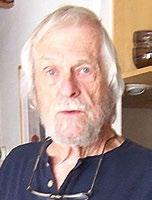
April 28, 2024, in Silver City, New Mexico. Born in Boston, Massachusetts, on August 26, 1929, John was the first child of his parents, Robert P. Rogers and Mildred J. Young Rogers. Part of his childhood was spent in Greenwich, Connecticut, but he attended middle and high school at the Putney School in Putney, Vermont, graduating in 1947. John then went to Reed, graduating with a bachelor’s degree in physics, before continuing his studies at the Massachusetts Institute of Technology, where he earned a bachelor’s in architecture in 1954.
John married Harriet Stupp, whom he had met at the Putney School, and the two eventually settled in Wellesley, Massachusetts, to raise their children, Patrick, Elizabeth, Amanda, and Jonathan. They divorced in 1978.
John practiced architecture most of his life, designing private homes throughout New England and a few educational buildings, including for the Sturbridge Village Museum in Massachusetts and the Putney School. There, he designed a dorm and worked with students to build the campus’s art building.
Later in life, John continued his architectural pursuits as he settled on Cape Cod with his partner, Diane Blackmoore LaFrance. He designed the home they eventually moved to in Silver City, New Mexico, in 2014. John also spent more time painting and making sculpture, participating in art shows in New Orleans and Provincetown. His last show was in December 2023 in Silver City.
John is survived by his partner of 40 years, Diane; his sister, Carly Rogers; his brother, Michael F. Rogers; and his exwife, Harriet S. Rogers, and their children, Patrick F. Rogers, Elizabeth F. Rogers, Amanda P. Jones, and Jonathan K. Rogers.
April 18, 2024, in Ambler, Pennsylvania, of complications from a stroke.
Verna Shmavonian was a retired director of research and technical staff for the Philadelphia City Council, award-winning filmmaker, and writer. She was born April 24, 1931, on Bainbridge Island, Washington, and attended Reed for two years before transferring to the University of Washington, where she earned her degree in English.

Known as an avid reader and freelance writer, Verna visited New York in 1952 as a guest editor for Mademoiselle magazine. She returned to Washington in 1953 and managed public relations and promotional activities for several departments at the university. When she was a student at UW, Verna met Barry Shmavonian, and they married in 1953 and had two children: daughter Nadya and son Karl.
The family lived in North Carolina from 1958 to 1969, where Verna worked for a community development program and as a writer for an educational TV station. In 1968, she produced No Handouts for Mrs. Hedgepeth, a short film about poverty and segregation in North Carolina that was named best social documentary of the year at the Atlanta Film Festival.
When the Shmavonians moved to Philadelphia, Verna worked on research projects for Temple University and city schools. She worked with the Free Library of Philadelphia and local schools to develop a pioneering learning center called the Action Library. In the ’70s, she protested against the Vietnam War, settled in East Mount Airy because of its well-established integration, and served as a Democratic committeewoman.
In 1980, Verna was hired by the then-president of the
city council, Joseph Coleman. Until her retirement in 1991, Verna oversaw a newly formed research unit that funneled information and data to council members and a tech staff that specialized in the expanding use of data processors and personal computers at City Hall.
Verna was considered naturally adept at organizing people and programs from start-up through job completion. She streamlined new procedures so council members could better analyze budgets, negotiate contracts, collect constituency data, and receive timely research and technical assistance on other initiatives.
In her free time, Verna liked to cook, garden, and entertain. Even long after she left North Carolina, neighbors regarded her home as the “Shmavonian House” because of the memorable get-togethers hosted there. Loved ones say she will be remembered for her intellect, her ability to balance career and family, her broad smile and healthy chortle, and her boundless love.
“She was sweet, sweet, sweet,” her daughter said in tribute. “Sweetness was her essence. She always had a smile and took pleasure in life. She was just happy.” Verna was predeceased by husband Barry in 2010 and is survived by her children and grandchildren.
David Henry Leonard ’55 February 3, 2024, in Louisville, Kentucky.
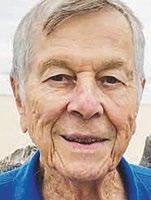
Born on March 20, 1933, Dave spent his early life on a homestead in northern Montana, where his mother, Helen Henderson Leonard, melted snow on the woodstove to wash his diapers. His family also spent time in
Salmon, Idaho, and Pony, Montana, where his father, Robert W. Leonard, worked as a teacher and principal.
Dave got involved with radio broadcasting at a young age as a student at Benson Polytechnic High School in Portland. He attended Reed (where his brother and sister had graduated) for a year in 1951, before leaving for Iowa State University. There, he worked at the student TV station. While in Ames, Iowa, Dave met his future wife, Mary Peterson, at a meeting of the Liberal Religious Youth. The pair would have three children, Julie, Peter, and Christopher.
Dave went on to earn a master of arts degree at Michigan State University before moving back to Portland to help set up a public TV station. Later, he worked for ETVNews in Bloomington, Indiana, and then managed the Pennsylvania Public Television Network and South Dakota Public Broadcasting. Dave also served multiple boards and organizations, including the Nature Conservancy of South Dakota, the Arts and Humanities Assembly of Boulder, and numerous Unitarian Universalist congregations and districts, becoming a beloved elder of the Boulder Valley Unitarian Universalist Fellowship.
The Leonard family often camped, hiked, and boated in different parts of the country. Dave continued to spend time in nature as he aged, hiking daily and sending much-loved photos of his adventures to friends until a stroke limited his activity. Dave was predeceased by his wife of 59 years, Mary Peterson Leonard; his brother, Robert C. Leonard ’52; and his sister, Helen Leonard Seagraves ’51. He is survived by his daughter, Julie, and his sons, Peter and Chris.
Robert Greenberg ’56
March 21, 2024, in Newton, Massachusetts, peacefully in his sleep. Bob was a beloved husband, de voted father, treasured grand father, and venerated professor. He taught philosophy to gen erations of students spanning more than 60 years—mostly at Brandeis University—and at tended Reed on a Baker Schol arship, majoring in philosophy, quarterbacking and coaching the football team, and running a laundry service to support himself.
After graduating, Bob went on to study as a Fulbright Scholar at St. Andrew’s and Oxford and a Woodrow Wil son Scholar at the University of Chicago, where he earned his PhD. Admired for his insight into Kant, metaphysics, and the history of philosophy, he wrote several books, including Theory of A Priori Knowledge (2001), Real Existence, Ideal Ne cessity (2008), and of Freedom: Kant’s Causal The ory of Action
Bob enjoyed a 60-year-long love affair with his wife, Maida Jablon Greenberg, supporting her career as a psychoanalyst by sharing the duties of shop ping for groceries, cooking fam ily dinners, and taking care of their children.
As a parent, Bob fulfilled everything he had longed for, having lost his own father to cancer at age six. He was a Little League coach—and inspired all three of his children to pursue PhDs and careers in academia.

Proudly liberal in his politics, Bob always sided with the underdog and bequeathed to all his descendants a concern for those less fortunate and a skepticism towards authority. He disdained cant and sloppy thinking, but was always open
Honor your professors and classmates with a gift to Reed in their name. You can make Reed possible for the next generation.
to revising his beliefs. To his grandchildren, he was a source of love, enthusiasm, and support, as well as a joyful leader of family gatherings around the dinner table in Newton and at the beach in Cape Cod.
Bob is survived by his wife, Maida, and his children, Judith, David, and Jonathan.
December 12, 2023, in Palo Alto, of pneumonia.
Dr. Priscilla Watson Laws was a pioneering physicist. Born in New York City and raised in San Francisco, Priscilla was a lifelong learner and teacher. She attended Lowell High School in San Francisco and studied physics at Reed before completing her master’s and doctorate in nuclear physics at Bryn Mawr College. It was there that she met her husband, Kenneth Laws; they married in 1965 and settled in Carlisle, Pennsylvania. The couple taught at Dickinson College and raised two children.
Priscilla’s career was marked by innovation and dedication. In the 1970s, she focused on the effects of X-ray radiation, contributing significantly to public understanding through her book The X-Ray Information Book and appearing on national television. She was also on the Pennsylvania Governor’s Energy Council during the Three Mile Island incident and served on the scientific advisory panel for the FDA’s Bureau of Radiological Health.
Priscilla’s attention turned to physics education in the 1980s, leading to the revolutionary “Workshop Physics” curriculum and development of lab equipment for PCs, notably with AtariLab. The equipment and curriculum she helped create are
still available today and are used at many colleges throughout the world.
Priscilla was recognized with the Dana Award for Education, the Milliken Award, and the Sears Roebuck Teaching Excellence Award. In 2003, she became a fellow of the American Physical Society.
Priscilla’s passion for education extended beyond the classroom. She served on various panels, including the National Science Foundation and the Department of Education’s FIPSE board. Her commitment to Carlisle was evident in her board roles for Carlisle Day Care, Carlisle Hospital Authority, the Carlisle Recycling Program, and the Unitarian Universalists of Cumberland Valley. Her dedication to social justice led to the Mozambique Bursary Project, supporting education for young women and girls in Africa.
Priscilla also loved hiking, reading (from her husband’s book on physics to novels by Barbara Kingsolver), and spending time with her grandchildren. She is survived by her children, Kevin and Virginia.
December 11, 2023, in Chicago, Illinois, of CIPD.
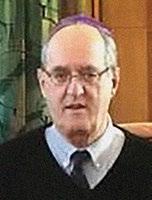
George was born in 1940 in the Bronx. In 1947, the family moved to Tucson, Arizona—and while it was a very small town at the time, George enjoyed living in the desert. Graduating from high school in 1958, he was inspired to enroll at Reed because of a high school science teacher that he admired.
At Reed, George enjoyed madrigal singing and majored in anthropology, writing his
thesis, “Voluntary Associations in Two West African Cities,” under Prof. David Heath French ’39 [anthropology 1947–88]. After graduation, George went to the University of Chicago, where he earned an MA and met his future wife, Jane Ganford.
After a few years of junior college teaching, George enrolled in the anthropology PhD program at Northwestern University. He returned to Arizona to research the Colorado River Indian Reservation and wrote his dissertation on the Chemehuevi Tribe, receiving his Ph.D. in 1976.
Following several years of teaching at California State University, San Bernardino, George was offered a chance to work on the newly established Federal Acknowledgement Project at the Bureau of Indian Affairs in Washington, DC. He loved the job and spent the rest of his anthropology career there, retiring in 2011.
George and Jane returned to Chicago in 2012, living in a senior retirement community. He was passionate about Renaissance music and went back to singing after retirement, taking private lessons and singing in chorales. A devoted family man, George is survived by his wife, Jane, and his two daughters. — Contributed by Suzanne Hanchett ’62 and Jane Roth

Susan Salasin ’64 July 15, 2018, in Oakland, California. Susan Crawford Salasin, after her experience as a survivor of violent crime at age 16, dedicated her life to advocating for others who had experienced the same trauma. She worked as an international adviser for trauma-informed
public health programs, keeping trauma on the public mental health agenda.
Susan was born in Portland, Oregon, on August 9, 1941, and studied psychology at Reed. Upon graduating, she married John Salasin ’63. They had two daughters, Elisa and Amanda, and moved to Maryland in 1972, where Susan began work with the National Institute for Mental Health, where she would serve survivors of violent crimes and tragedies for four decades.
While at NIMH, Susan served as a liaison in developing the Victims of Crime Act (VOCA) through the Department of Justice, and provided testimony for the President’s Task Force on Crime Victims for the U.S. Following the passage of VOCA, she consulted with the United Nations Center for Humanitarian Affairs in the development of the original United Nations Declaration of Basic Principles of Justice for Victims of Crime and Abuse of Power.
During the 1990s and early 2000s, Susan codirected a national project on designing and evaluating trauma-integrated services, a breakthrough in women’s trauma treatment. In 2012, her life’s work was commemorated with the founding of the Salasin Project and the Salasin Center for Women and Children, which provides opportunities to build community for survivors of domestic violence and their families.
In 2014, Susan relocated to Oakland, where she died at age 76 with her daughters by her side. She was predeceased by her husband, John, and is survived by her daughters, Elisa Simon and Amanda Salasin. She will be remembered for her pioneering work in violence
prevention, as well as for her lively, bright soul.
Druscilla Shipman ’64
July 1, 2016, in Chicago, Illinois. Druscilla Shipman was a dynamic artist. Over the course of her life, she dedicated time to many art forms—literature, painting, and photography, to name a few.
Dru was born December 3, 1942. She graduated from Reed with a bachelor’s degree in literature, completing a collection of poetry for her thesis called “This Wide Bird” under adviser Prof. James Dickey [English and poet-in-residence, 1962–64]. She continued her studies at the School of the Art Institute of Chicago, earning another bachelor’s in painting in 1970.
Dru didn’t stop there— she earned a master’s degree in photography in 1973, also from the SAIC. After her education, Dru wrote several articles on photography, including a review of Susan Sontag as a critic for Afterimage: The Journal of Media Arts and Cultural Criticism.
Over the course of her career, Dru taught in the fine arts at Haverford College, Bryn Mawr College, and Indiana University Bloomington. She also served on the board of directors for the Society for Photographic Education.
Sandra Goodrick ’66 April 11, 2024, in Seattle, Washington. Sandra Clark Goodrick could often be found gardening, quilting, crafting with stationery, and perhaps most of all, reading. In particular, she loved mystery novels, and her tastes ranged from Agatha Christie and Rex Stout to Lee Child and Michael Connelly to Hazel Holt and M. C. Beaton.
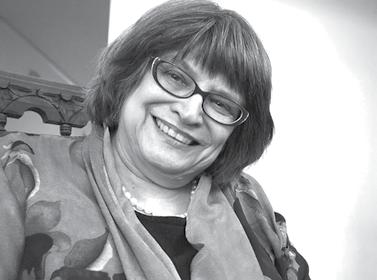
Sandy, as she was known to friends, was born in Santa Monica, California on June 17, 1945, and was raised between there and the Midwest until she enrolled at Reed in 1962. While at Reed, she met and married Ray Raphael ’65, in 1963, and they participated in activism together during the civil rights movement before parting amicably. Sandy studied at Reed until 1966 and finished her bachelor’s degree in English literature in 1971 at Berkeley, where she met her second husband, Richard Goodrick. The two settled in the Berkeley Hills and had a son, John.
In the late ’80s, Sandy and her family moved to Seattle, where she discovered her love of mystery novels. Sandy spent a lot of time as a patron of the now-closed Seattle Mystery Bookshop on Cherry Street, and she led the Seattle Mystery Readers Club, which sometimes met there. The owner of the shop found the newsletter Sandy wrote for the club so charming that he asked her to write one for the bookshop, too. She soon became the shop’s bookkeeper and the writer of its newsletter, which was widely read and adored by mystery lovers.
In her last years, Sandy lived at the Ida Culver House in the Ravenna neighborhood of Seattle. She is survived by her husband, Richard, and her son, John. Sandy is remembered by loved ones for her warm laugh; her keen, thoughtful observations; and her devotion to her friends.
Arrita “Peri” Frantz ’67
March 1, 2024, in Peterborough, New Hampshire, with her husband and children by her side.
A longtime programmer and an adventurous explorer, Peri was born on March 25, 1946, in Los Angeles. She grew up in Berkeley and studied chemistry at Reed, but after a brief stint as a chemist, she transitioned to computers and worked as a programmer for many years. She eventually started her own business, Periwinkle Computer Consulting, and also worked as a QA specialist and engineering manager at Apple.
Outside of work, Peri dedicated her time to the international community of people who explore, study, and protect caves. Every summer, she would travel to caving events in Europe, China, Botswana, and Malaysia. When not underground, she took on many leadership roles, including secretary/treasurer of the National Speleological Society. She is survived by her husband, Bill, and her sons, Jefferson and Ethan.
Leonard Brackett ’70
April 17, 2023, in Nevada City, California, of cancer.

Known by loved ones as Len, Lenny, and Pop, Leonard Brackett embraced life as one long, joyous adventure. Whether charming his roommates into turning their off-campus house into a zendo, honoring the ancient art of Japanese carpentry, or becoming a revered master falconer, Len’s curiosity, optimism, and awe for the planet’s beauty inspired his every undertaking. Diagnosed with lung cancer at the age of 76, he faced illness not as a patient but as a pilgrim.


Love Reed? Join the volunteers supporting students and shaping the future of the college. Find which volunteer opportunities await you.
reed.edu/volunteer
Born January 23, 1947, Len was the youngest of four children. He proudly described his childhood as both perfect and perfectly feral. Raised on Lake Minnetonka in Minnesota, Len, a born athlete, grew up ice boating and playing hockey in the winter, sailing and water skiing in the summer, and making boyish mischief not to be recounted here. Len also spent time woodworking and tinkering—hobbies he would practice in different forms for the rest of his life.
When he attended Reed in the late ’60s, majoring in American literature and Japanese studies, Len quickly found a community. After living in the Sisson dorm his freshman year, he and David Simon ’70, Bob Wollheim ’70, Frank Poliat ’70, Laura Shill Schrager ’70 , and Sam Schrager ’70 moved into an off-campus house called the Cosmos. Introduced to Zen by his sister’s husband, Roshi Richard Baker, with tatami and pillows Len and his roommates transformed the living room of the Victorian house into a domestic zendo where Portlanders could come to meditate. For his senior year, Len moved with Sam to an off-grid cabin in the Columbia Gorge and wrote his thesis, a movie script of Gary Snyder ’51’s poem “Mountains and Rivers Without End,” by kerosene lamplight.
After graduating in 1970, Len traveled to Japan. Serendipitously, he met an abbot at a temple in Kyoto, who, upon learning about Len’s interest in carpentry, connected him to a group of skilled local craftsmen. For five years, Len apprenticed alongside his teachers, working grueling 80-hour weeks to learn the craft of Japanese temple carpentry.
In Kyoto, Len met and married Toshiko Mishima. A son, Sylvan Mishima Brackett ’98 (see Eating a Moment , page 14), was born in 1975, shortly before the family returned to the Northern California Sierras. Deep in the Inimim Forest on the San Juan Ridge, working only with hand tools, Len built the traditional Japanese house that became the flagship for his design-build company, East Wind (Higashi Kaze) Inc.
The Bracketts lived in their off-the-grid home with generator-powered electricity and well water. A daughter, Aya Mishima Brackett, was born in 1979. After their marriage ended, Toshiko and Len shared birthdays, holidays, and vacations with their growing family.
Len’s life’s work was adapting Japanese architecture to Western expectations. Although fame meant little to Len, who was self-deprecating by nature, East Wind became the preeminent builder of Japanese houses in the U.S. Despite the beauty of his work, Len resisted being called artistic or creative—he was a craftsman. His buildings in California, Washington, Colorado, Hawaii, Massachusetts, and Germany, he said, would last centuries, a testament to the tradition he loved.
Len encouraged his children to pursue their own dreams, as he had done. Sylvan became a chef, and Aya became a photographer. Len and Aya collaborated when he coauthored a book, Building the Japanese House Today , and Aya captured the photos for it. When his son opened a restaurant in San Francisco, Len created its authentic Japanese interior and lovingly advised Sylvan on balancing a business with family life.
Grandpa Len adored his four grandchildren, sharing with them his boyhood love of firecrackers and motorbikes.
In 2012, Len married Anna Villegas. Anna says Len was “congenitally happy,” fearless, and endlessly upbeat. For Len, nothing was impossible, whether it was trapping the bear who had broken into the kitchen, removing an interior wall in the midst of a January snowstorm, or coaxing a skeptical goshawk mother into accepting an adopted chick.
In later years, Len bequeathed East Wind to his finest apprentice. When he wasn’t woodworking, Len was busy felling cedars, tending his cherry trees, and reading arcane histories. In the last decade of his life, he curated a unique relationship with a goshawk named Phoebe, who lived freely in the forest but always returned to her benefactor. About his land, his goshawk, his buildings, and his family, Len was forever enthusiastic. He is survived by his partner of 25 years, Anna, and his children, Sylvan and Aya.
Sylvan and Aya say whether their father was mechanicking, woodworking, or befriending birds, he lived his life on his own maverick terms. Even facing a daunting illness, Len considered himself blessedly lucky. “If this is the end, I don’t have any regrets,” Len told lifelong friend David Simon shortly before he died. “I got to do exactly what I wanted to do.”
Arthur Dushin ’86
March 20, 2024, in Boxborough, Massachusetts.
Fred, an architect and software developer who embodied the intellectually adventurous spirit of Reed throughout his life, died
in hospice care near the home he shared with his wife, Marguerite (Margot), and son, Alexander, in Boxborough, Massachusetts. He was 60 years old.
Raised on a horse farm in the forests of New York’s Hudson Valley, Fred was the son of Leona Hauff Dushin, an equestrian, and Frank Edward Dushin, an architect. While Fred considered emulating his father by enrolling in an architecture college, he ultimately picked Reed and chose to study philosophy and religion, sparked by his fascination with mathematician and philosopher Alfred North Whitehead.
“One day, Fred looked unusually animated, and before I could ask, he told me he was reading Whitehead’s Process and Reality,” remembers Fred’s friend Steve Halpern ’85. “In a few minutes, Fred excitedly distilled Whitehead’s metaphysics in such a clear, concise way that even I could understand it.”
Whitehead’s work featured in Fred’s thesis, “Toward an Ethnography of Furniture,” written under Prof. William Peck [philosophy 1961–2002], but he was equally eager to test his mind and his body. He could be found at Quaker and anti-nuclear proliferation meetings, yet was also known to hitchhike to Government Camp and snowshoe on the slopes of Mount Hood.
After graduating from Reed, Fred earned an MA in philosophy and an MS in computer science at Syracuse University, where he met Margot. He eventually settled in Massachusetts, where he cultivated his careers in architecture and software, all while coaching soccer, advocating for the environmental stewardship of his town, tinkering with his vintage Land Rover, and creating
microcircuitry for miniature electronic devices.
Fred’s Reed friends experienced him as an articulate, soft-spoken, warm, inquisitive, and consistent companion. “Fred was a kind of presence—a presence of kindness, of empathic understanding,” says Stephanie Guyer-Stevens ’86. She remembers Fred’s “sideways smile” and notes that he taught her “how to be a true friend, how to enjoy the company of other human beings, and how to find the cosmic joke in most situations.”
Fred is survived by his loving wife of 24 years, Margot, and their son, Alex.
On February 28, 2024, in Phoenix, Arizona, of cancer.

Tracy was born October 14, 1957, in Missoula, Montana. He graduated from Reed with a degree in classics in 1986, having written his thesis, “Studies in Pindaric Interpretation,” under Prof. Richard Tron [classics 1961–2003]. A long-distance runner with a vast collection of medals and trophies, Tracy was known for his work ethic and always going the extra mile. When he passed away, he had
recently retired from the Vanguard Group, an investment management company, after a long and successful career in financial services. Family, friends, and colleagues remember him as caring, friendly, and the kind of person to make others feel special. He was predeceased by his father, Gerald DeWayne Johnson, and his stepfather, Walter P. “Bud” Myrdal. Tracy is survived by his mother, Norma Jean Myrdal.
April 3, 2024, in Portland, Oregon.
An insightful critic and a dedicated poet, Carolyn discovered her love for the written word during childhood. Born August 28, 1980, in Los Angeles, she had memorized poems by E.E. Cummings and T.S. Eliot by the time she was a teenager, and would recite them as she and her sister walked home from the school bus stop.
At Reed, Carolyn wrote her thesis, “The Cultural Storm: Modernism and Mass Culture in Nathanael West’s Miss Lonelyhearts and The Day of the Locust,” under Prof. Lois Leveen [English and humanities 2000–03]. She also earned a master of arts at Portland State University and a master of social work in animal-assisted therapy at the Smith College School for Social Work.
Carolyn enjoyed a distinguished career as a writer. She was published in the Los Angeles Times Book Review, and in 2006, she won first place in the graduate division of the Jane Austen Society of North America’s annual essay contest. Her essay, “Fanny’s Excellence,” was an illuminating plunge into the psyche of Fanny Price, the oft-underestimated protagonist of Austen’s Mansfield Park.
Committed to improving animal welfare, Carolyn was devoted to her four rescue dogs, Angie, Bella, Blue, and Molly. She also worked as an English instructor, a research analyst, and—over the course of a decade—a script judge at the P.I.F.F. and Southeastern Film Festival. One of the crowning achievements of her career was The Wild Part, a book of poetry she self-published in 2023.
Carolyn’s life reflected both her passion for her work and her love of play. Before she passed away, she wrote, “Play is a critical part of life, and it’s unfortunate adults are expected to put it aside. Play can be writing, painting, sports, fashion, beauty—whatever makes you happy. You don’t have to be good at it, or get paid for it, or become famous for it. Sometimes the best work comes out of doing something because it gives you joy.”
March 7, 2024, in Nashville, Tennessee, of brain cancer.
Alex Morgan, born December 1, 1998, lived authentically and truthfully, basking in their vast interests: cephalopods, Earl Grey, blueberry milkshakes, the band the Mountain Goats, Studio Ghibli movies, “repurposed” black clothing, and Life of Pi. On the flip side, they stuck by their convictions about what they hated, too: inequality, lemons, Amazon, arrogance, and the fact that George R.R. Martin still hasn’t finished writing the sixth book in the Song of Ice and Fire series.
In high school, Alex was a quiz bowl champion, cofounder of a social justice group, and Senior of the Year. Their touchstones throughout their life were language and books. Alex was known for frequently
devouring a book a day, typically science fiction and fantasy. They wrote both shortand long-form fiction, and bonded with others about their love of ideas, often exchanging book recommendations.
When Alex came to Reed, they explored these passions by studying comparative literature. A scholar of Chinese culture and language, Alex studied in China at Peking University in 2020. Their thesis, completed under Prof. Alexei Ditter [Chinese], reflected on femininity, masculinity, and adolescence in two mid-Qing-Dynasty novels.
Shortly after their graduation from Reed, Alex was diagnosed with a malignant brain tumor and underwent treatment while pursuing a master’s degree in library science at the University of Washington. Alex practiced Judaism, taking comfort in the mysteries of faith. They are survived by their fiancée, Jessica Riaño, and their parents, David Morgan and Karen Bloch, and their brother, Nicholas Morgan. By their loved ones, Alex will be remembered for their wit, wisdom, and unfailing empathy, gentleness, and kindness.
Forthcoming obituaries: Gail-Marie Shearer ’47, William Berleman ’53, Robert Cahill ’54, Karen Ezekiel ’56, Robert Hoyt ’56, Steve Knutson ’63, Robert Buckley MA ’64, Leslie Lischka ’64, Karen Oppenheim Mason ’64, Gerald Chakerian ’68, Peter Dickinson ’69, Rochelle Savit ’70, Lisa Betros ’74, Nancy J. Tivenan ’75, Rebecca Rach ’79, Dr. Sasha Stein ’97, Vincent J. Berkun ’99, Brian Andrews ’05, Ben Hemenway ’16, Prof. Larry Church [chemistry 1973–80], Prof. Geraldine Deries [French and humanities 1992–96]

By the early third century CE, the Roman Empire was no longer synonymous with just the city of Rome: a common elite Roman culture was widespread across the Mediterranean, and men from the provinces regularly gained senatorial rank or rose through the ranks of the Roman army to wield political power.
The Severan Tondo, discussed in Ancient Mediterranean Studies 382: Material Culture and Empire, demonstrates this. Painted in Egypt circa 200 CE, this object depicts the family of Septimius Severus, the reigning emperor, shown in the
upper right. Severus was born in Leptis Magna in what is now Libya, spoke Latin with a Punic accent, and was declared emperor by his legions in what is now Austria. In the upper left is his wife Julia Domna, from Emesa (modern Homs), Syria. Their son Caracalla is in the bottom right. The Severan Tondo challenges the popular conception of ancient Rome as solely European: a North African emperor, his Syrian wife, and their family are depicted on a work of art produced in Egypt.
The tondo is also notable for the void in the bottom left, where Caracalla’s brother Geta
had been depicted. Caracalla and Geta ruled as co-emperors after Severus’s death in 211 CE, but later that same year Caracalla had Geta murdered and ordered a damnatio memoriae: Geta’s image and name were removed from both public and private monuments. Geta officially did not exist, and the gaping hole is purposefully left to remind the viewer that, even in the home, the emperor commands them to forget him and his memory. Or else. —Prof. Thomas Landvatter


BY NAMING REED AS A BENEFICIARY,
you can secure Reed’s future with the stroke of a pen.
You can give all or a portion of the remainder of your:
• retirement accounts, such as an IRA, 403b, or 401k;
• life insurance policies;
• commercial annuities;
• donor-advised funds;
• bank and investment accounts.
Contact your plan administrator to update your beneficiary designation form, and rest assured that your gift will support future students and faculty engaged in intellectual pursuit.




3203 SE Woodstock Blvd.
Portland, Oregon 97202-8138
